russian army dump corpses of killed Ukraine civilians in supermarket "Щирий кум" Svobody Avenue in Mariupol
You are using an out of date browser. It may not display this or other websites correctly.
You should upgrade or use an alternative browser.
You should upgrade or use an alternative browser.
Live Conflict Ukraine-Russia War
- Thread starter Kartal1
- Start date
Western sanctions will bite. Many captured Russian equipment has Western components on critical parts, most notably microelectronics. It's going uphill for Russia to replace losses from here, and if this war drags on to 2023 Russia will be a spent force. They lose like 10 tanks per day.
Yup:

Captured Russian Weapons Are Packed With U.S. Microchips
Ukraine intelligence showed us lists of mostly U.S.-made microchips it says were found on captured or destroyed Russian military equipment.
The video shows close combat in the trench.
The enemy drone helping to the russian team, the alone Ukrainian soldier resists them to the end.
Ukraine soldier succeeds twice to throwing back the enemy grenades and delaying the enemy advance.
But 1 Ukrainian vs 5 russian plus 1 drone helping russians it was way to much
The enemy drone helping to the russian team, the alone Ukrainian soldier resists them to the end.
Ukraine soldier succeeds twice to throwing back the enemy grenades and delaying the enemy advance.
But 1 Ukrainian vs 5 russian plus 1 drone helping russians it was way to much
Italian 155-mm FH-70 howitzers appeared in Ukraine. The howitzer was put into service in 1976. The FH70 is a towed/self-propelled howitzer. Howitzer rate of fire, up to 4-6 rounds per minute. The firing range of the FH-70 howitzer with conventional ammunition is 24 km, with American active-reactive ammunition up to 30 km. In general, the howitzer was successful for its time, provided that the gunners were well trained.
Since March of this year, Russia began using Su-57 aircraft in Ukraine, TASS reported. Although the bulk of the Ukrainian air defense launchers have already been disabled, there are still a number of S-300 air defense systems, Buk air defense systems and a large number of MANPADS. Su-57s in Ukraine “operate outside the zone of active destruction by air defense systems, using long-range missile weapons of the R-37M missile, with a flight range of 200 km.
The work of the combat crew of the Russian self-propelled guns 2S7M "Malka" in Ukraine. Self-propelled guns with a caliber of 203 mm are designed to solve special tasks - suppression and elimination of especially protected command posts, artillery, mortars, and armored vehicles.
A Russian armored personnel carrier was ambushed by mercenaries in Ukraine.. In the video, you can see a shot of a mercenary from an RGW 90 MATADOR grenade launcher at a Russian BTR-80, despite 2 hits, the BTR continued the fight and retreated into the forest, where it was abandoned by the crew and blown up by the Ukrainian army. The video is incomplete, there are no shots of a grenade launcher hitting an armored personnel carrier.
Since March of this year, Russia began using Su-57 aircraft in Ukraine, TASS reported. Although the bulk of the Ukrainian air defense launchers have already been disabled, there are still a number of S-300 air defense systems, Buk air defense systems and a large number of MANPADS. Su-57s in Ukraine “operate outside the zone of active destruction by air defense systems, using long-range missile weapons of the R-37M missile, with a flight range of 200 km.
The work of the combat crew of the Russian self-propelled guns 2S7M "Malka" in Ukraine. Self-propelled guns with a caliber of 203 mm are designed to solve special tasks - suppression and elimination of especially protected command posts, artillery, mortars, and armored vehicles.
A Russian armored personnel carrier was ambushed by mercenaries in Ukraine.. In the video, you can see a shot of a mercenary from an RGW 90 MATADOR grenade launcher at a Russian BTR-80, despite 2 hits, the BTR continued the fight and retreated into the forest, where it was abandoned by the crew and blown up by the Ukrainian army. The video is incomplete, there are no shots of a grenade launcher hitting an armored personnel carrier.
Italian 155-mm FH-70 howitzers appeared in Ukraine. The howitzer was put into service in 1976. The FH70 is a towed/self-propelled howitzer. Howitzer rate of fire, up to 4-6 rounds per minute. The firing range of the FH-70 howitzer with conventional ammunition is 24 km, with American active-reactive ammunition up to 30 km. In general, the howitzer was successful for its time, provided that the gunners were well trained.
Since March of this year, Russia began using Su-57 aircraft in Ukraine, TASS reported. Although the bulk of the Ukrainian air defense launchers have already been disabled, there are still a number of S-300 air defense systems, Buk air defense systems and a large number of MANPADS. Su-57s in Ukraine “operate outside the zone of active destruction by air defense systems, using long-range missile weapons of the R-37M missile, with a flight range of 200 km.
The work of the combat crew of the Russian self-propelled guns 2S7M "Malka" in Ukraine. Self-propelled guns with a caliber of 203 mm are designed to solve special tasks - suppression and elimination of especially protected command posts, artillery, mortars, and armored vehicles.
A Russian armored personnel carrier was ambushed by mercenaries in Ukraine.. In the video, you can see a shot of a mercenary from an RGW 90 MATADOR grenade launcher at a Russian BTR-80, despite 2 hits, the BTR continued the fight and retreated into the forest, where it was abandoned by the crew and blown up by the Ukrainian army. The video is incomplete, there are no shots of a grenade launcher hitting an armored personnel carrier.
You are a complete joke, mate.
According to International LAW of loans payment russian is in state of DEFAULT. Legally it is officially started on 25 MAY. According to international signed document russian have Exactly ONE MONTH to provide the money, otherwise on 25 JUNE russian WILL be In State of DEFAULT to all of the WORLD.
I would like to explain IT IS NOT ABOUT ONLY PAYMENT. It is about International LAW and procedure WHICH russia MUST FOLLOW to SEND ALL MONEY and PAPERS related to LOAN.
FACT is that russia CAN NOT ABLE TO DO IT and THAT WHY russia have less then 30 days left as last option according to Contract and then the DEFAULT.
OTHER FACT ALL international Agency WHICH have the Licenses to DO that they CAN NOT Accept any order from russia BECAUSE OF EMBARGO.
CONCLUSION NO MATTER WHAT russia WILL be in DEFAULT officially at 25 JUNE.
Source: It is not ENGLISH
 twistedtimes.org
twistedtimes.org

 www.13abc.com
www.13abc.com

 finance.yahoo.com
finance.yahoo.com
I would like to explain IT IS NOT ABOUT ONLY PAYMENT. It is about International LAW and procedure WHICH russia MUST FOLLOW to SEND ALL MONEY and PAPERS related to LOAN.
FACT is that russia CAN NOT ABLE TO DO IT and THAT WHY russia have less then 30 days left as last option according to Contract and then the DEFAULT.
OTHER FACT ALL international Agency WHICH have the Licenses to DO that they CAN NOT Accept any order from russia BECAUSE OF EMBARGO.
CONCLUSION NO MATTER WHAT russia WILL be in DEFAULT officially at 25 JUNE.
Source: It is not ENGLISH
US forcing Russia to default – what about investors? UPDATE
 twistedtimes.org
twistedtimes.org

US to end Russia’s ability to pay international investors
The U.S. is expected to end Russia’s ability to pay bondholders through American banks, setting up Russia to default this summer.
Explainer-U.S. Treasury pushes Russia towards default: What next?
The lapse of a key U.S. license allowing Russia to make payments on its sovereign debt to U.S. holders has put the prospect of the country defaulting on its sovereign debt back into focus. Russia is due to pay $100 million in interest on two sovereign bonds on Friday, with more payments coming...
Russians are happy because they are winning in the Donbas. The Russians, with their numerous cannons, are pushing aside the sporadic and belated deliveries of cannons to Ukraine from the West.
The Russians, with their numerous cannons, are pushing aside the sporadic and belated deliveries of cannons to Ukraine from the West.
Firepower solves everything: Special operation artillery "Z"

"Hyacinth-S". Source: rutube.ru
Salvo weight
The determining factor on the Ukrainian battlefields was the weight of the artillery salvo – the larger it is, the more effective the defense and offensive. In the first phase of the special operation, the role of artillery was not so decisive. Firstly, the rapid tank and amphibious breakthroughs of February 2022 did not involve massive artillery training. In the best case, the enemy's scouted cluster was worked out with cruise or tactical missiles. Secondly, apparently, at the beginning of the operation, the Russian troops simply did not have enough barrel and rocket artillery of the regimental and divisional-army levels. But right now this technique plays a crucial role in all sectors of the Ukrainian front. Figuratively speaking, the conflict, which began as a typical operation of the XXI century, has now moved to the realities of the mid-XX century. A lot now depends on the "gods of war", and the domestic artillery successfully copes with the tasks. First of all, the enemy openly admits this. In numerous reports, mercenaries and homegrown nationalists complain of serious artillery pressure. A fighter of the 25th separate Airborne Brigade of the Armed Forces of Ukraine in an interview explained:
"The situation is very bad... Russian troops are simply destroying everything with artillery, firing day and night."
The mercenary Povilas Limontas , who escaped home to Lithuania , echoes him:
Russian Russian artillery: "If you have engaged in a firefight with the Russians, then you have only 10 minutes before the start of the raid on your positions by Russian artillery."
Kiev propagandist and the main "pacifier" of Ukraine Arestovich openly says that the nationalists in the Donbas are retreating under the blows of long-range artillery and missiles. And, of course, it demands from the West the next supply of heavy weapons. The last time the Germans were appointed guilty, delaying the delivery of Leopard, Gepard and Marder.

"Msta-S". Source: wikipedia.org
During interrogations, the prisoners confirm that the main losses of the Ukrainian side are from artillery fire. In some units, up to 40-50% of the personnel were knocked out by artillery raids. And this is quite natural. Unlike the first phase of the Russian offensive, now the troops are moving forward only after a preliminary artillery sweep. This, by the way, is the reason for the seemingly unhurried development of events in the Donbas now. It must be understood that the enemy is saturated with high–tech equipment - kamikaze drones, reconnaissance UAVs, thermal imagers, modern ATGMs and MANPADS. It is much easier to grind it not even by aviation, but by artillery fire. As the American analyst and former UN inspector Scott Ritter rightly noted, the ability to penetrate enemy defenses with artillery and missiles will win the battle for a very long time. And Ukraine is no exception here. Simply because the Western "hi-tech" supplied by Western countries is much more likely to fail than, for example, the D-30 howitzer and the Acacia self-propelled gun. For example, the batteries of the infamous Javelin in some products were simply discharged. Ritter generally expressed doubts about the effectiveness of the F-35 fighters, praised only on paper. High-tech weapons are good only when there is a quiet and safe airfield nearby. It's good to bomb somewhere over Afghanistan, and then land and have a cup of coffee while technicians are servicing capricious electronics. And when positions at the front and rear units are shelled around the clock, the unpretentiousness and reliability of equipment comes to the fore here. With this, the Russian artillery, like the rest of the military equipment, is all right.

No one openly talks about the presence of the newest Russian "Coalition-SV" in the Ukrainian theater of military operations. However, a lot of cars have already been produced (about 50 copies), so we can assume that now is the time to test this high-precision weapon in combat conditions. Source: wikipedis.org
An important reason for the widespread use of artillery was the "green" Ukraine. Simply put, even with a reconnaissance quadcopter, sometimes the location of enemy units is not always visible. Rather than endanger the next column of armored vehicles, it is much more reasonable to plow the "green" with shells in advance. Military telegram channels are saturated with views of Ukrainian fields dotted with thousands of artillery arrivals. Not Verdun, of course, but very close. In principle, according to this scheme, the offensive of the Russian army is now taking place. First, reconnaissance (ground or air), then a neat artillery barrage, then tanks and infantry. In much the same way, the Red Army smoked out the Wehrmacht during the Vistula-Oder operation. At a certain point, the Germans learned to crawl away to the second line of defense, wait out the artillery attack, and then return back, meeting the advancing tanks and infantry with fire. In response to the trick, they received a smooth movement of the front of Soviet artillery fire from the front edge deep into the Wehrmacht defense.
Hacking Defense
The situation of the Ukrainian troops will worsen every day. It's all about the positions they are now leaving in the Donbas. For 8 years they managed to build a new Maginot line, which can be taken head-on after total destruction by heavy artillery. No one is going to do this, so the nationalists are either locked in boilers or forced to retreat. And where to retreat? In an open field, forests and cities. In all cases, so-so fortifications from the artillery raid. It is not for nothing that we see more and more evidence of plowed Ukrainian dugouts and trenches on the edges of the forest. Not a single fortified area comparable to the Donbass one has been created throughout Ukraine up to the very western border. Of course, with the exception of cities and industrial enterprises. But here the nationalists perfectly understand what this threatens with the example of the history of bandits from Azovstal. That is why the personnel of the Armed Forces of Ukraine and the National Security Forces will continue to die under shells and missiles or will wisely go into captivity.
Among the advantages of the Allied artillery on the battlefields of Ukraine there are several of the most indisputable. First of all, Russia has a much larger resource in technology, and it is very specific for different conditions. The quality and weight of the Russian artillery salvo is now a key factor in hacking the Ukrainian defense. Multiple launch rocket systems of three calibers – 122-mm "Grad" / "Tornado-S", 220-mm "Hurricane" and 300-mm "Tornadoes". Of course, some systems have their roots in the 70s of the last century, but this does not lose their relevance at all. 152-mm barrel artillery is represented by two howitzers at once – "Acacia" and "Msta-S", and a self-propelled gun "Hyacinth-S". The "Reserve of the Main Command" is represented by a 203-mm gun "Malka" and a 240-mm mortar "Tulip". With Malka, the situation is generally unique. In most cases, this weapon is not afraid of the counter–battery struggle of the Armed Forces of Ukraine - the firing range allows you to work with impunity on the principle of a "long arm". At the regimental level of self–propelled vehicles - 122-mm "Carnation", 120-mm "Nona" and "Vienna". And this is just a list of self-propelled artillery capable of being quickly transferred from one section of the front to another and even evading return fire. Ukraine, we recall, has already lost more than one and a half thousand of its artillery systems. Neither the United States nor any other NATO country has even approximately the amount of artillery that Russia can oppose. Only 152-mm guns "Hyacinth-B" more than 1 thousand, and the number of howitzers D-30 is selected to 5 thousand. The Europeans and the Americans will be able to provide Ukraine with at least approximate parity only by completely cleaning out their arsenals. And this means that the potential for Western arms supplies will eventually run out.

D-30 at the rehearsal of the Victory Parade in Donetsk. The gun, of course, is outdated, but it has not lost its relevance in the conditions of a special operation. Source: wikipedia.org
It is not necessary to assume that the domestic artillery strikes exclusively on squares. All equipment, if possible, works in conjunction with drones for correction and reconnaissance, which allows you to quickly respond to threats and avoid unnecessary casualties. It is also important that the allied forces at this stage are much better provided with shells than the Ukrainians – this allows concentrated fire to be conducted almost around the clock. The flow of ammunition for the APU equipment will gradually dry up – there is no production for Soviet-style calibers in NATO countries, as there are none in Ukraine itself. The remaining artillery depots are either already in the liberated territory, or partially destroyed. The Ukrainian nationalists lack the ability to destroy logistics supply chains deep in the rear of the Allied forces. Unlike Russia, which does not seem to be taking full advantage of this. And French Caesar, Italian FH-70 and American "three axes" M777 appear on the front. It is impossible to underestimate this technique, but imports will inevitably pose a difficult question of repair and operation. Even if the guns remain intact, the situation even with the planned repair of such a motley company will not be easy – the combat conditions are far from hothouse European. It is enough to look at the lightweight carriage of the air transportable M777 to understand how long it will last on the front roads.
We must pay tribute to the Ukrainian gunners – they have learned to hit targets accurately over eight years of shelling. This has already been recognized more than once by the Russian military. There are several reasons: firstly, accurate intelligence from the Americans, secondly, the widespread use of spotter drones, and thirdly, the AN/TPQ-36 counter-battery systems, of which there are at least 20 pieces in Ukraine. However, the accuracy of the Ukrainian artillery is not massive on the fronts. In fact, artillery raids are possible only in areas where there is weak intelligence and counter-battery fighting. Pockets of resistance, albeit high-tech weapons, will always remain, and they become priority targets during the artillery hacking of defense.
Author:
Evgeny Fedorov
The Russians, with their numerous cannons, are pushing aside the sporadic and belated deliveries of cannons to Ukraine from the West.
Firepower solves everything: Special operation artillery "Z"
"Hyacinth-S". Source: rutube.ru
Salvo weight
The determining factor on the Ukrainian battlefields was the weight of the artillery salvo – the larger it is, the more effective the defense and offensive. In the first phase of the special operation, the role of artillery was not so decisive. Firstly, the rapid tank and amphibious breakthroughs of February 2022 did not involve massive artillery training. In the best case, the enemy's scouted cluster was worked out with cruise or tactical missiles. Secondly, apparently, at the beginning of the operation, the Russian troops simply did not have enough barrel and rocket artillery of the regimental and divisional-army levels. But right now this technique plays a crucial role in all sectors of the Ukrainian front. Figuratively speaking, the conflict, which began as a typical operation of the XXI century, has now moved to the realities of the mid-XX century. A lot now depends on the "gods of war", and the domestic artillery successfully copes with the tasks. First of all, the enemy openly admits this. In numerous reports, mercenaries and homegrown nationalists complain of serious artillery pressure. A fighter of the 25th separate Airborne Brigade of the Armed Forces of Ukraine in an interview explained:
"The situation is very bad... Russian troops are simply destroying everything with artillery, firing day and night."
The mercenary Povilas Limontas , who escaped home to Lithuania , echoes him:
Russian Russian artillery: "If you have engaged in a firefight with the Russians, then you have only 10 minutes before the start of the raid on your positions by Russian artillery."
Kiev propagandist and the main "pacifier" of Ukraine Arestovich openly says that the nationalists in the Donbas are retreating under the blows of long-range artillery and missiles. And, of course, it demands from the West the next supply of heavy weapons. The last time the Germans were appointed guilty, delaying the delivery of Leopard, Gepard and Marder.
"Msta-S". Source: wikipedia.org
During interrogations, the prisoners confirm that the main losses of the Ukrainian side are from artillery fire. In some units, up to 40-50% of the personnel were knocked out by artillery raids. And this is quite natural. Unlike the first phase of the Russian offensive, now the troops are moving forward only after a preliminary artillery sweep. This, by the way, is the reason for the seemingly unhurried development of events in the Donbas now. It must be understood that the enemy is saturated with high–tech equipment - kamikaze drones, reconnaissance UAVs, thermal imagers, modern ATGMs and MANPADS. It is much easier to grind it not even by aviation, but by artillery fire. As the American analyst and former UN inspector Scott Ritter rightly noted, the ability to penetrate enemy defenses with artillery and missiles will win the battle for a very long time. And Ukraine is no exception here. Simply because the Western "hi-tech" supplied by Western countries is much more likely to fail than, for example, the D-30 howitzer and the Acacia self-propelled gun. For example, the batteries of the infamous Javelin in some products were simply discharged. Ritter generally expressed doubts about the effectiveness of the F-35 fighters, praised only on paper. High-tech weapons are good only when there is a quiet and safe airfield nearby. It's good to bomb somewhere over Afghanistan, and then land and have a cup of coffee while technicians are servicing capricious electronics. And when positions at the front and rear units are shelled around the clock, the unpretentiousness and reliability of equipment comes to the fore here. With this, the Russian artillery, like the rest of the military equipment, is all right.
No one openly talks about the presence of the newest Russian "Coalition-SV" in the Ukrainian theater of military operations. However, a lot of cars have already been produced (about 50 copies), so we can assume that now is the time to test this high-precision weapon in combat conditions. Source: wikipedis.org
An important reason for the widespread use of artillery was the "green" Ukraine. Simply put, even with a reconnaissance quadcopter, sometimes the location of enemy units is not always visible. Rather than endanger the next column of armored vehicles, it is much more reasonable to plow the "green" with shells in advance. Military telegram channels are saturated with views of Ukrainian fields dotted with thousands of artillery arrivals. Not Verdun, of course, but very close. In principle, according to this scheme, the offensive of the Russian army is now taking place. First, reconnaissance (ground or air), then a neat artillery barrage, then tanks and infantry. In much the same way, the Red Army smoked out the Wehrmacht during the Vistula-Oder operation. At a certain point, the Germans learned to crawl away to the second line of defense, wait out the artillery attack, and then return back, meeting the advancing tanks and infantry with fire. In response to the trick, they received a smooth movement of the front of Soviet artillery fire from the front edge deep into the Wehrmacht defense.
Hacking Defense
The situation of the Ukrainian troops will worsen every day. It's all about the positions they are now leaving in the Donbas. For 8 years they managed to build a new Maginot line, which can be taken head-on after total destruction by heavy artillery. No one is going to do this, so the nationalists are either locked in boilers or forced to retreat. And where to retreat? In an open field, forests and cities. In all cases, so-so fortifications from the artillery raid. It is not for nothing that we see more and more evidence of plowed Ukrainian dugouts and trenches on the edges of the forest. Not a single fortified area comparable to the Donbass one has been created throughout Ukraine up to the very western border. Of course, with the exception of cities and industrial enterprises. But here the nationalists perfectly understand what this threatens with the example of the history of bandits from Azovstal. That is why the personnel of the Armed Forces of Ukraine and the National Security Forces will continue to die under shells and missiles or will wisely go into captivity.
Among the advantages of the Allied artillery on the battlefields of Ukraine there are several of the most indisputable. First of all, Russia has a much larger resource in technology, and it is very specific for different conditions. The quality and weight of the Russian artillery salvo is now a key factor in hacking the Ukrainian defense. Multiple launch rocket systems of three calibers – 122-mm "Grad" / "Tornado-S", 220-mm "Hurricane" and 300-mm "Tornadoes". Of course, some systems have their roots in the 70s of the last century, but this does not lose their relevance at all. 152-mm barrel artillery is represented by two howitzers at once – "Acacia" and "Msta-S", and a self-propelled gun "Hyacinth-S". The "Reserve of the Main Command" is represented by a 203-mm gun "Malka" and a 240-mm mortar "Tulip". With Malka, the situation is generally unique. In most cases, this weapon is not afraid of the counter–battery struggle of the Armed Forces of Ukraine - the firing range allows you to work with impunity on the principle of a "long arm". At the regimental level of self–propelled vehicles - 122-mm "Carnation", 120-mm "Nona" and "Vienna". And this is just a list of self-propelled artillery capable of being quickly transferred from one section of the front to another and even evading return fire. Ukraine, we recall, has already lost more than one and a half thousand of its artillery systems. Neither the United States nor any other NATO country has even approximately the amount of artillery that Russia can oppose. Only 152-mm guns "Hyacinth-B" more than 1 thousand, and the number of howitzers D-30 is selected to 5 thousand. The Europeans and the Americans will be able to provide Ukraine with at least approximate parity only by completely cleaning out their arsenals. And this means that the potential for Western arms supplies will eventually run out.
D-30 at the rehearsal of the Victory Parade in Donetsk. The gun, of course, is outdated, but it has not lost its relevance in the conditions of a special operation. Source: wikipedia.org
It is not necessary to assume that the domestic artillery strikes exclusively on squares. All equipment, if possible, works in conjunction with drones for correction and reconnaissance, which allows you to quickly respond to threats and avoid unnecessary casualties. It is also important that the allied forces at this stage are much better provided with shells than the Ukrainians – this allows concentrated fire to be conducted almost around the clock. The flow of ammunition for the APU equipment will gradually dry up – there is no production for Soviet-style calibers in NATO countries, as there are none in Ukraine itself. The remaining artillery depots are either already in the liberated territory, or partially destroyed. The Ukrainian nationalists lack the ability to destroy logistics supply chains deep in the rear of the Allied forces. Unlike Russia, which does not seem to be taking full advantage of this. And French Caesar, Italian FH-70 and American "three axes" M777 appear on the front. It is impossible to underestimate this technique, but imports will inevitably pose a difficult question of repair and operation. Even if the guns remain intact, the situation even with the planned repair of such a motley company will not be easy – the combat conditions are far from hothouse European. It is enough to look at the lightweight carriage of the air transportable M777 to understand how long it will last on the front roads.
We must pay tribute to the Ukrainian gunners – they have learned to hit targets accurately over eight years of shelling. This has already been recognized more than once by the Russian military. There are several reasons: firstly, accurate intelligence from the Americans, secondly, the widespread use of spotter drones, and thirdly, the AN/TPQ-36 counter-battery systems, of which there are at least 20 pieces in Ukraine. However, the accuracy of the Ukrainian artillery is not massive on the fronts. In fact, artillery raids are possible only in areas where there is weak intelligence and counter-battery fighting. Pockets of resistance, albeit high-tech weapons, will always remain, and they become priority targets during the artillery hacking of defense.
Author:
Evgeny Fedorov
Angry thread about M270 MLRS and M142 HIMARS 
and a bit about BM-27 Uragan and BM-30 Smerch too.
Angry, because every M270 and M142 thread I have seen on twitter so far is FULL OF MIND BOGGLING ERRORS... because all of them (!) use as source of their "knowledge" the
1/n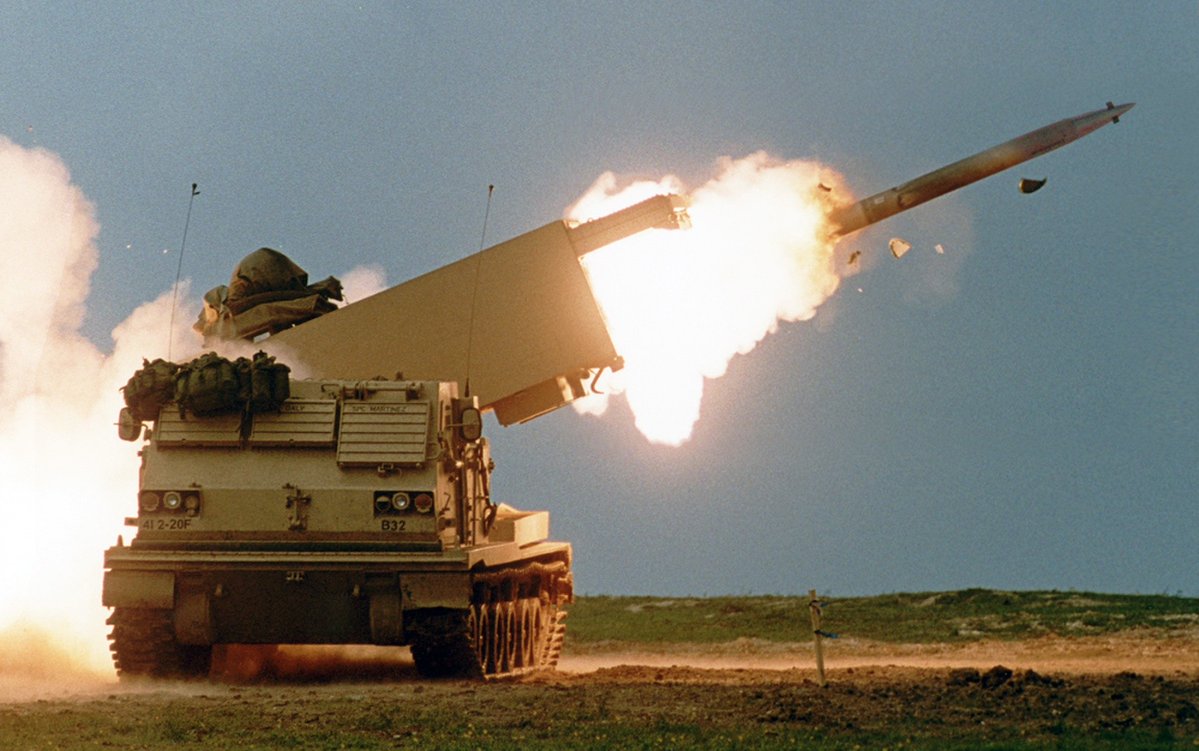

error-filled M270 wikipedia article...

Let's dive in. First: M270 and M142 are technologically decades ahead of their Soviet-era counterparts: BM-27 Uragan and BM-30 Smerch. See the red arrows I painted? Yes, those are optical sights...
2/n

Uragan and Smerch have to be sighted optically... and in the case of the Uragan soldiers have to adjust elevation and deflection by turning wheels.
Even Uragan's two outriggers have to be lowered and emplaced by muscle power.
3/n
Optical sights means that it takes the 10-12 minutes to measure and prepare a launch sites and sight a launchers.
Firing dumb rockets with optical sight also means that the Uragan and Smerch's accuracy is atrocious... i.e. when a Smerch fires its 12 rockets,
4/n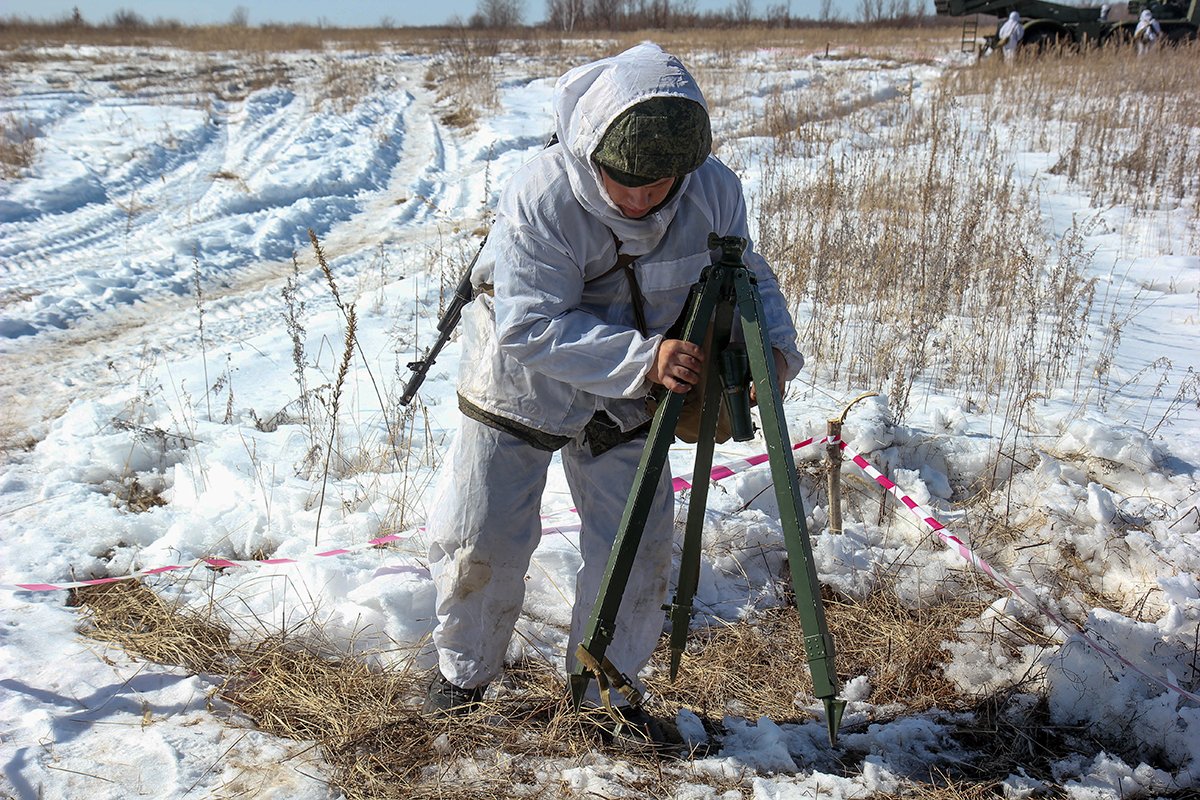
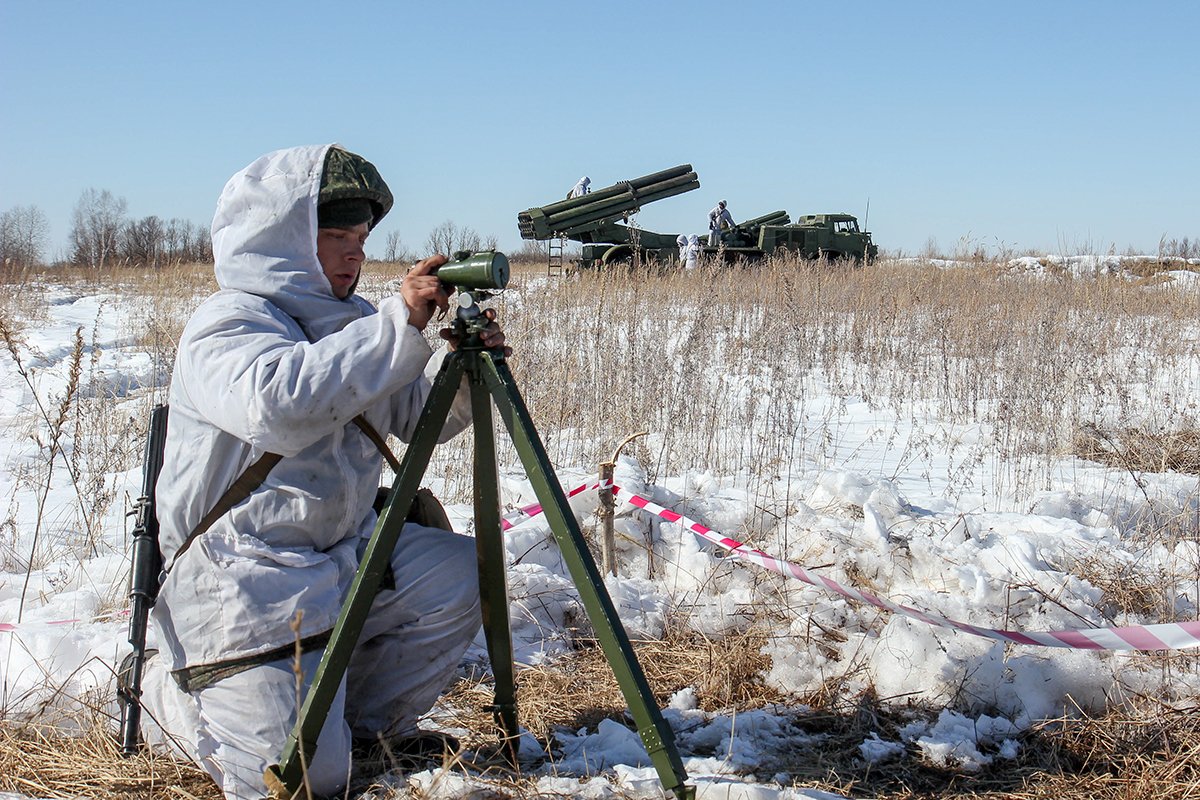
then the circular error probable (CEP) is 170 meter. This means only 50% of rockets fall within a 170 meter radius of the actual target... the other 50% will come down even further away than 170 meter from the target.
Meanwhile US GLMRS missiles have a CEP of 5 meters.
5/n
This is the reason russian forces fire mostly rockets with cluster munitions. They know they can't hit a target, so they saturate the area around a target with cluster munitions, hoping that at least something will hit...
Photo: remnants of Uragan cluster munition rockets.
6/n
And reloading the Uragan and Smerch is a time-consuming drag... It takes 20 minutes to reload a Uragan and it takes 5x russians 40 minutes to load 12x rusty rockets into a Smerch.
7/n
Ukraine also uses Uragan and Smerch, but russia has bombed Ukraine's rocket factories and as no allied nation produces Uragan or Smerch rockets, Ukraine desperately needs M270 and/or M142 launchers with their more accurate missiles.
8/n
Besides the accuracy of their missiles, what else makes the M270 and M142 so much better?
For starters: the speed of reloading. Both use rocket pods pre-loaded at the factory with either six GMLRS missiles of the same type or one ATACMS missile. Trucks bring the pods to
9/n
predesignated ammo supply points, where M270/M142 exchange their used pods for new ones in 5 minutes thanks to their built in cranes.
Meanwhile the truck is already on its way to get more pods.
And if you're in a hurry - the M270 can reload its pods simultaneously.ously.
10/n
And how do the M270 and M142 aim their missiles?
Well, with a top-secret tool called "keyboard". This must sound like magic to russian soldiers with their sights and collimators.
All M270s in US/NATO service and all M142 fire GPS-guided missiles, which are aimed via the
11/n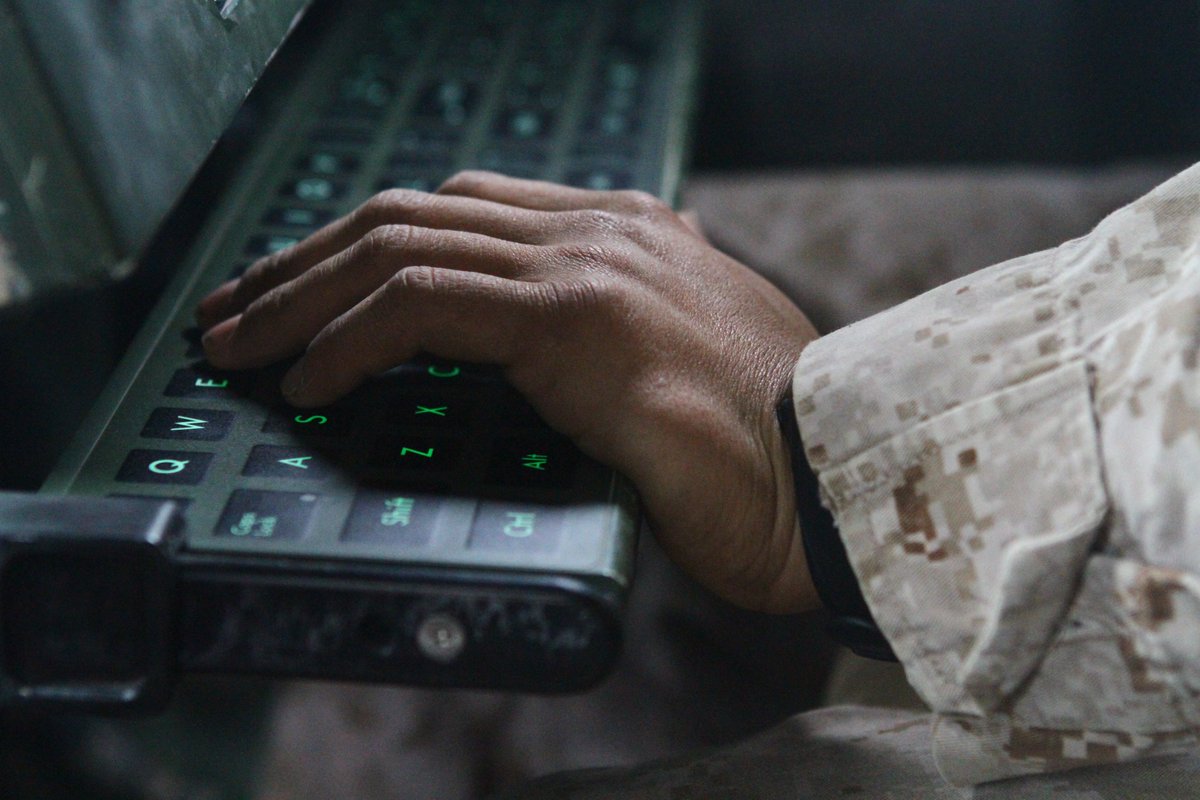
M270A1's Improved Fire Control System (IFCS - left photo) or the M142's Universal Fire Control System (UFCS - right photo).
Since 4QFY21 the M270A1's IFCS is being replaced by the Common Fire Control System (CFCS), which will allow upgraded M270A2 to fire the
12/n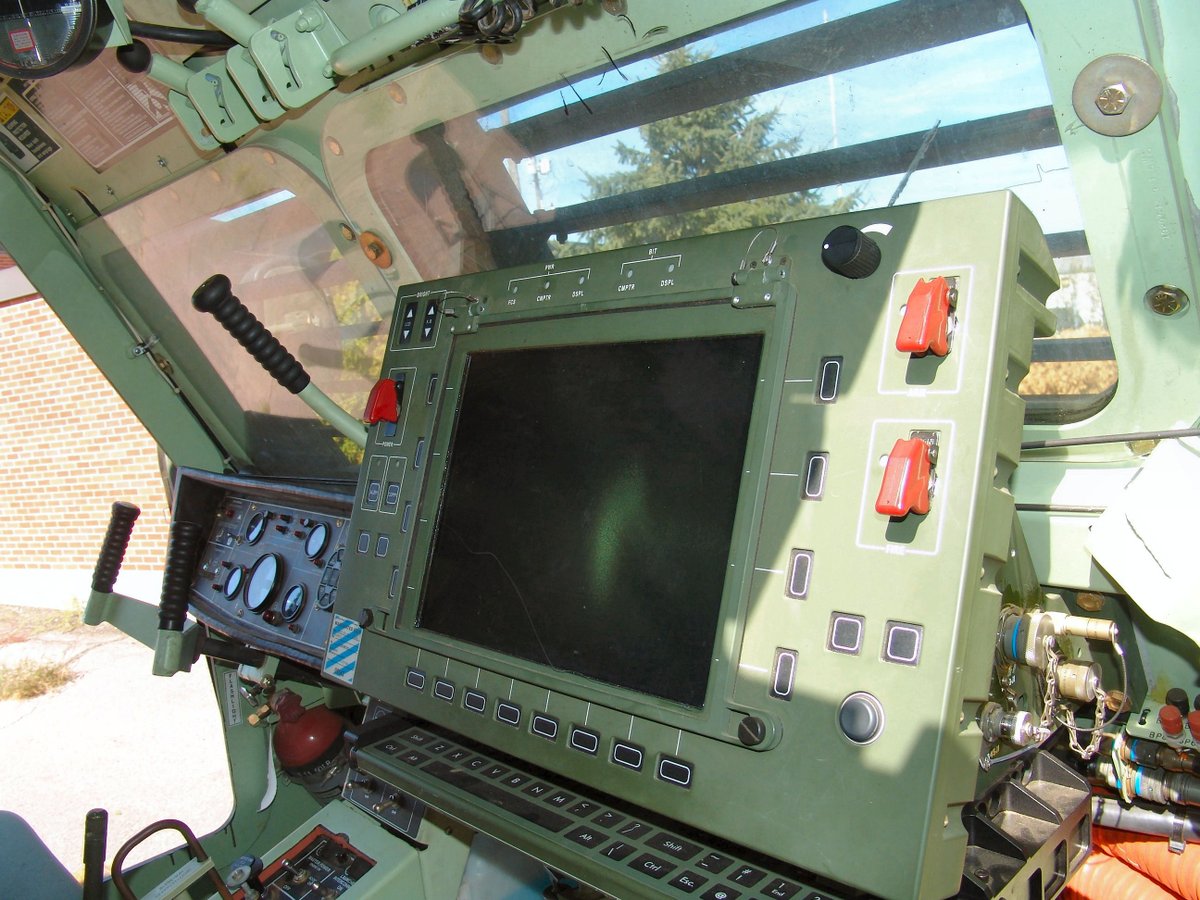
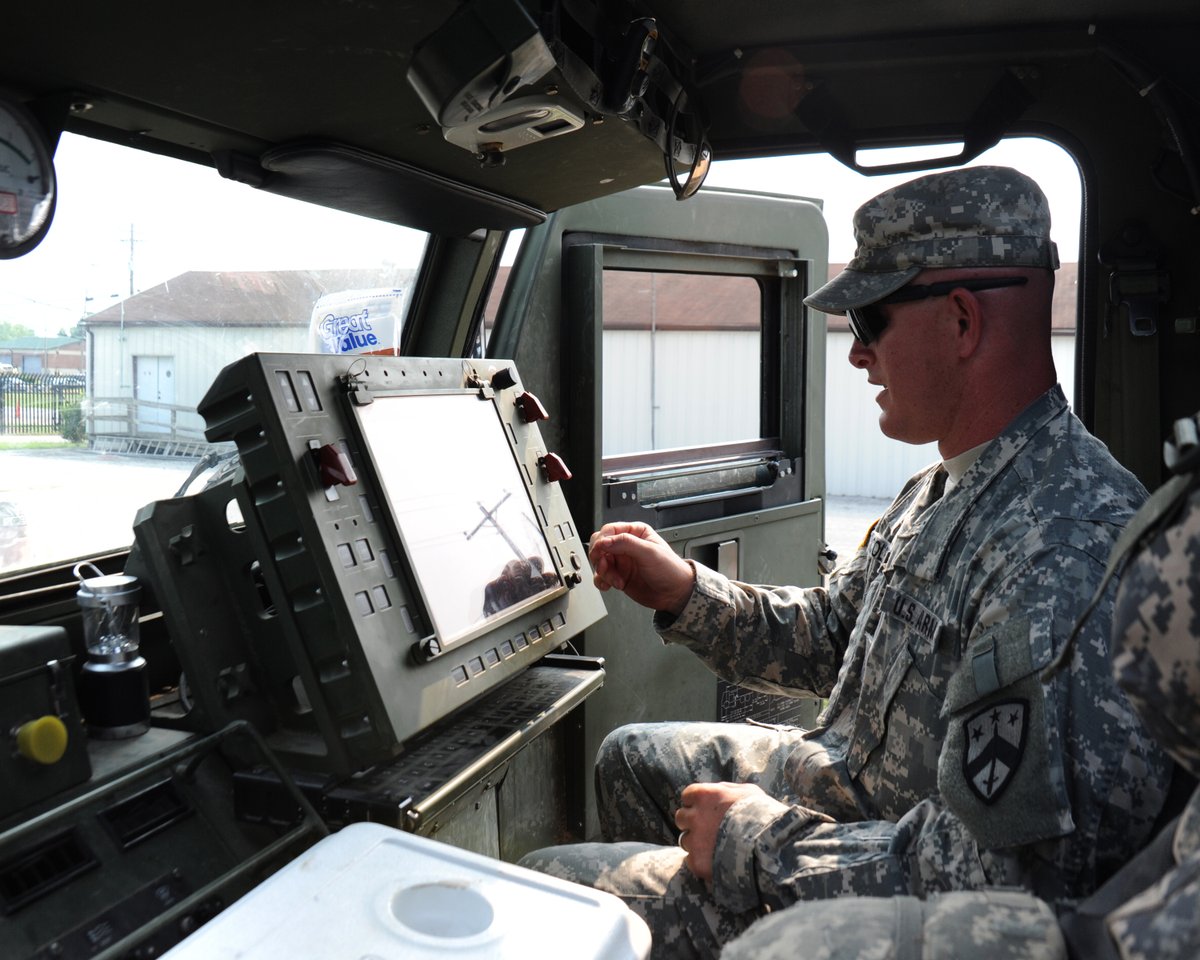
future Precision Strike Missile (PrSM). Which brings us to the types of missiles that exist (or existed or will exist) for the two systems:
• M26
• M28
• M30/M31
• M39/M48/M57
• PrSM
13/n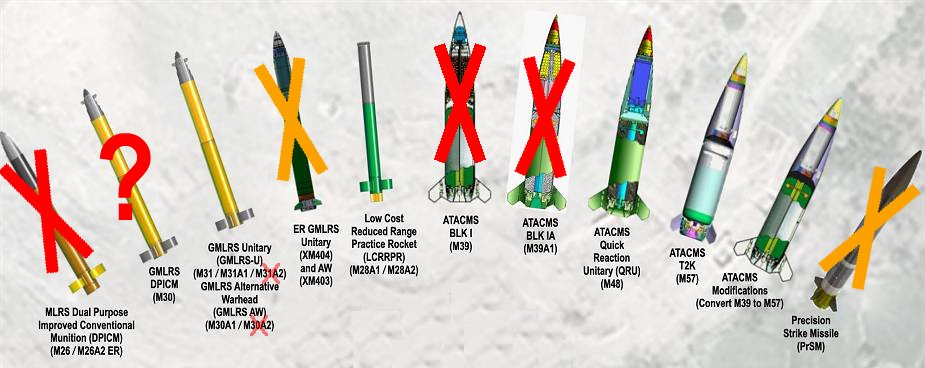
The M26 series were unguided, cluster munitions rockets. The US Army acquired 506,718 and used around 17,000.
The M26 and the extended range M26A2 were carrying M77 submunitions, which had a fail rate of more than 5%. The M26A1 was an extended range version of the M26
14/n
carrying the more advanced M85 submunitions with a dud rate of about 4% (pictured).
However in 2008 the Bush administration instituted a policy to retain and use only cluster munitions with a dud rate of less than 1% or less after 2018.
15/n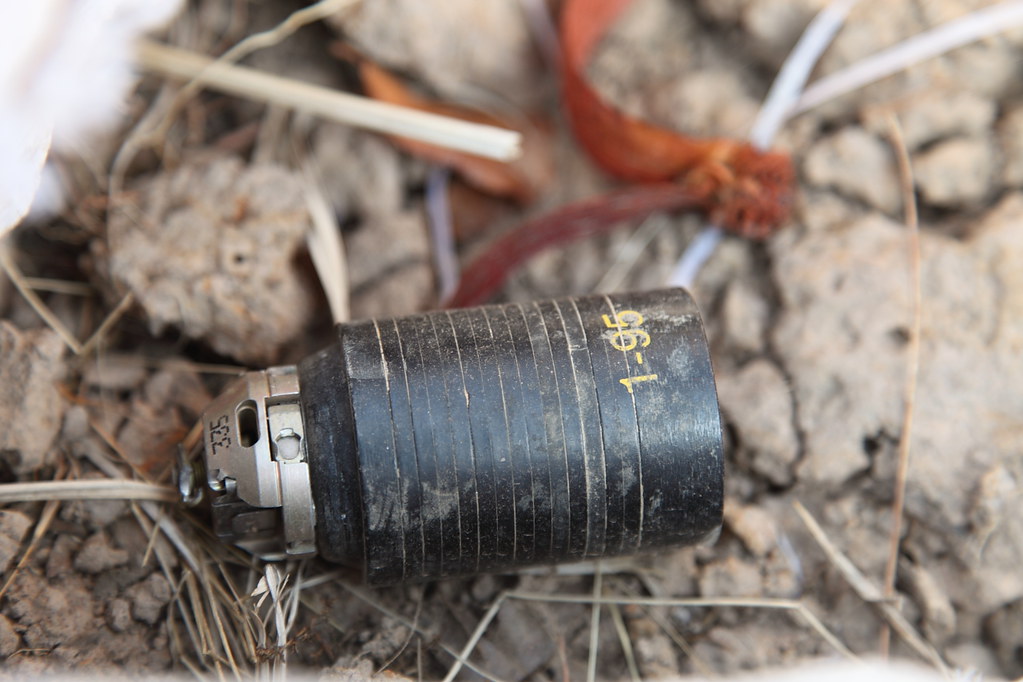
Already in 2007 the US Army had begun a program to dismantle its M26 rockets by 2019 and by 2012 98,904 M26s had been dismantled.
In 2017 the Trump administration canceled the Bush administration's cluster munitions policy and as of 2022 it is unknown if - and if yes,
16/n
how many - M26 rockets are are still in US possession. However the US Army (and all NATO allies) have no M26 rockets in their active stockpiles for at least the last 10 years.
The M28 series are a reduced range practice rounds of no interest to us.
17/n
The M30 series consists of two GPS-guided missiles (GMLRS) with different warheads:
• M30 - with M101 cluster munitions (2% duds)
• M30A1 - Alternative Warhead, with 160,000+ Tungsten balls - it is like a giant shotgun
From 2004 to 2009 the Army bought 2,475 M30,
18/n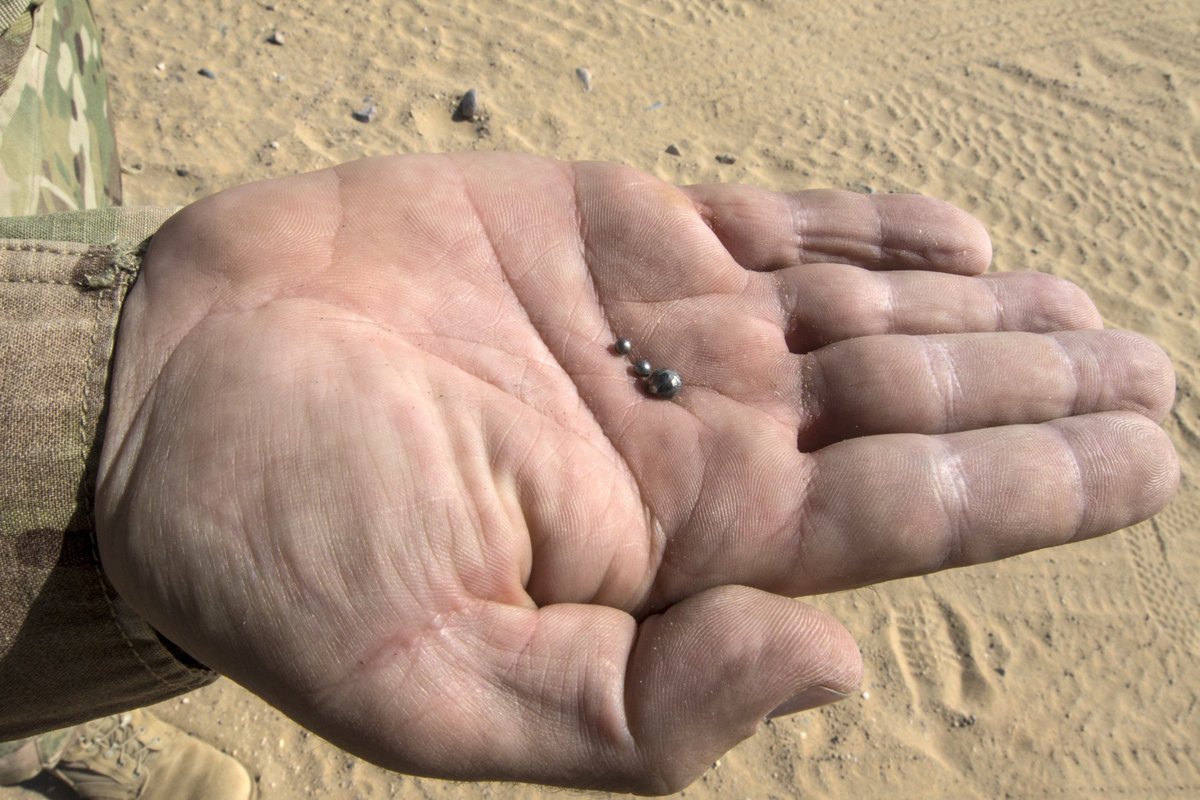
but because of the 2% fail rate of the M101 cluster munitions the army stopped buying the M30 in 2009 and focused on developing the M30A1.
All M30s cluster warheads were scheduled to be replaced by M30A1 Alternative Warheads by 2019.
19/n
As of 2022 it is unclear if, and if yes how many, M30 missiles are still in the US arsenal.
The M31 and M31A1 are variants of the M30 GMLRS missile with unitary high-explosive warheads.
Lockheed Martin produces about 11,000 M30A1 and M31A1 GMLRS missiles per year, and the
20/n
US military has as of 2022 at least 60,000 GMLRS in its arsenal.
In 2022 the M30A2 (aka XM403) and M31A2 (aka XM404) will replace the two A1 variants in production.
As the US does not plan to give Ukraine the longer range ATACMS missiles I will dicuss them only in brief:
21/n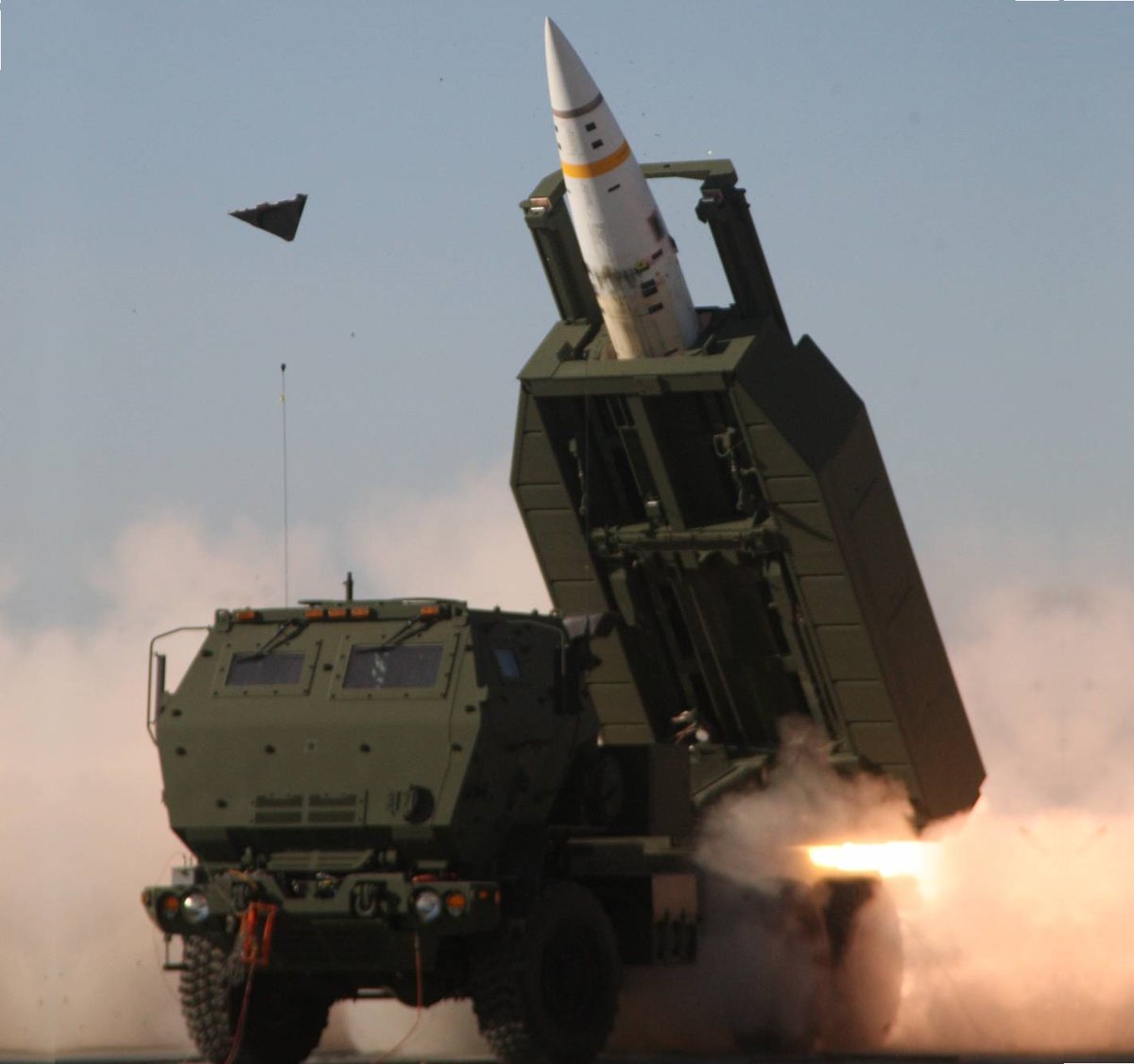
• M39 - with M74 cluster munitions (the "steel rain" of Desert Storm) - only non GPS-guided ATACMS
• M39A1 - longer range, GPS-guided M39 variant with reduced M74 payload
The Army planned to have both either dismantled or rebuilt as M57 by 2020.
22/n
• M48 - with unitary warhead, 176 produced in 2001-04, of which 58 were used during OEF/OIF
• M57 - with unitary warhead, improved CEP, and new fuze, 513 produced 2004-13, 47 used
It is likely only the M57 (new and rebuilt M39/M39A1) remain in the US military's arsenal.
23/n
As of 2022 Lockheed is in the process of modernizing the ATACMS missiles to extend their service life until the Precision Strike Missile (PrSM) enters service in 2027.
All of this tells us that Ukraine will receive M30A1, M31, and M31A1 missiles.
24/n
People tweeting that Ukraine will get M26 rockets, M30 missiles, XM403/404 missiles, GMLRS ER missiles, etc. don't know what they are talking about.
And yes, the arrival of M270 or M142 will be a turning point, as my next thread will show.
russian troops are doomed.
25/n
Part II of this thread - including maps about how the situation at the front will change with the arrival of M270A1 or M142 systems - begins with this tweet:

 threadreaderapp.com
threadreaderapp.com
and a bit about BM-27 Uragan and BM-30 Smerch too.
Angry, because every M270 and M142 thread I have seen on twitter so far is FULL OF MIND BOGGLING ERRORS... because all of them (!) use as source of their "knowledge" the
1/n


error-filled M270 wikipedia article...
Let's dive in. First: M270 and M142 are technologically decades ahead of their Soviet-era counterparts: BM-27 Uragan and BM-30 Smerch. See the red arrows I painted? Yes, those are optical sights...
2/n


Uragan and Smerch have to be sighted optically... and in the case of the Uragan soldiers have to adjust elevation and deflection by turning wheels.
Even Uragan's two outriggers have to be lowered and emplaced by muscle power.
3/n
Optical sights means that it takes the 10-12 minutes to measure and prepare a launch sites and sight a launchers.
Firing dumb rockets with optical sight also means that the Uragan and Smerch's accuracy is atrocious... i.e. when a Smerch fires its 12 rockets,
4/n


then the circular error probable (CEP) is 170 meter. This means only 50% of rockets fall within a 170 meter radius of the actual target... the other 50% will come down even further away than 170 meter from the target.
Meanwhile US GLMRS missiles have a CEP of 5 meters.
5/n
This is the reason russian forces fire mostly rockets with cluster munitions. They know they can't hit a target, so they saturate the area around a target with cluster munitions, hoping that at least something will hit...
Photo: remnants of Uragan cluster munition rockets.
6/n

And reloading the Uragan and Smerch is a time-consuming drag... It takes 20 minutes to reload a Uragan and it takes 5x russians 40 minutes to load 12x rusty rockets into a Smerch.
7/n
Ukraine also uses Uragan and Smerch, but russia has bombed Ukraine's rocket factories and as no allied nation produces Uragan or Smerch rockets, Ukraine desperately needs M270 and/or M142 launchers with their more accurate missiles.
8/n
Besides the accuracy of their missiles, what else makes the M270 and M142 so much better?
For starters: the speed of reloading. Both use rocket pods pre-loaded at the factory with either six GMLRS missiles of the same type or one ATACMS missile. Trucks bring the pods to
9/n

predesignated ammo supply points, where M270/M142 exchange their used pods for new ones in 5 minutes thanks to their built in cranes.
Meanwhile the truck is already on its way to get more pods.
And if you're in a hurry - the M270 can reload its pods simultaneously.ously.
10/n
And how do the M270 and M142 aim their missiles?
Well, with a top-secret tool called "keyboard". This must sound like magic to russian soldiers with their sights and collimators.
All M270s in US/NATO service and all M142 fire GPS-guided missiles, which are aimed via the
11/n

M270A1's Improved Fire Control System (IFCS - left photo) or the M142's Universal Fire Control System (UFCS - right photo).
Since 4QFY21 the M270A1's IFCS is being replaced by the Common Fire Control System (CFCS), which will allow upgraded M270A2 to fire the
12/n


future Precision Strike Missile (PrSM). Which brings us to the types of missiles that exist (or existed or will exist) for the two systems:
• M26
• M28
• M30/M31
• M39/M48/M57
• PrSM
13/n

The M26 series were unguided, cluster munitions rockets. The US Army acquired 506,718 and used around 17,000.
The M26 and the extended range M26A2 were carrying M77 submunitions, which had a fail rate of more than 5%. The M26A1 was an extended range version of the M26
14/n
carrying the more advanced M85 submunitions with a dud rate of about 4% (pictured).
However in 2008 the Bush administration instituted a policy to retain and use only cluster munitions with a dud rate of less than 1% or less after 2018.
15/n

Already in 2007 the US Army had begun a program to dismantle its M26 rockets by 2019 and by 2012 98,904 M26s had been dismantled.
In 2017 the Trump administration canceled the Bush administration's cluster munitions policy and as of 2022 it is unknown if - and if yes,
16/n
how many - M26 rockets are are still in US possession. However the US Army (and all NATO allies) have no M26 rockets in their active stockpiles for at least the last 10 years.
The M28 series are a reduced range practice rounds of no interest to us.
17/n
The M30 series consists of two GPS-guided missiles (GMLRS) with different warheads:
• M30 - with M101 cluster munitions (2% duds)
• M30A1 - Alternative Warhead, with 160,000+ Tungsten balls - it is like a giant shotgun
From 2004 to 2009 the Army bought 2,475 M30,
18/n

but because of the 2% fail rate of the M101 cluster munitions the army stopped buying the M30 in 2009 and focused on developing the M30A1.
All M30s cluster warheads were scheduled to be replaced by M30A1 Alternative Warheads by 2019.
19/n
As of 2022 it is unclear if, and if yes how many, M30 missiles are still in the US arsenal.
The M31 and M31A1 are variants of the M30 GMLRS missile with unitary high-explosive warheads.
Lockheed Martin produces about 11,000 M30A1 and M31A1 GMLRS missiles per year, and the
20/n
US military has as of 2022 at least 60,000 GMLRS in its arsenal.
In 2022 the M30A2 (aka XM403) and M31A2 (aka XM404) will replace the two A1 variants in production.
As the US does not plan to give Ukraine the longer range ATACMS missiles I will dicuss them only in brief:
21/n

• M39 - with M74 cluster munitions (the "steel rain" of Desert Storm) - only non GPS-guided ATACMS
• M39A1 - longer range, GPS-guided M39 variant with reduced M74 payload
The Army planned to have both either dismantled or rebuilt as M57 by 2020.
22/n
• M48 - with unitary warhead, 176 produced in 2001-04, of which 58 were used during OEF/OIF
• M57 - with unitary warhead, improved CEP, and new fuze, 513 produced 2004-13, 47 used
It is likely only the M57 (new and rebuilt M39/M39A1) remain in the US military's arsenal.
23/n
As of 2022 Lockheed is in the process of modernizing the ATACMS missiles to extend their service life until the Precision Strike Missile (PrSM) enters service in 2027.
All of this tells us that Ukraine will receive M30A1, M31, and M31A1 missiles.
24/n
People tweeting that Ukraine will get M26 rockets, M30 missiles, XM403/404 missiles, GMLRS ER missiles, etc. don't know what they are talking about.
And yes, the arrival of M270 or M142 will be a turning point, as my next thread will show.
russian troops are doomed.
25/n

Part II of this thread - including maps about how the situation at the front will change with the arrival of M270A1 or M142 systems - begins with this tweet:

Thread by @noclador on Thread Reader App
@noclador: Angry thread about M270 MLRS and M142 HIMARS 🧵 and a bit about BM-27 Uragan and BM-30 Smerch too. Angry, because every M270 and M142 thread I have seen on twitter so far is FULL OF...
M270 MLRS or M142 HIMARS?
Which of the two will Ukraine receive?
And how will this change the war?
A missile artillery thread
1/n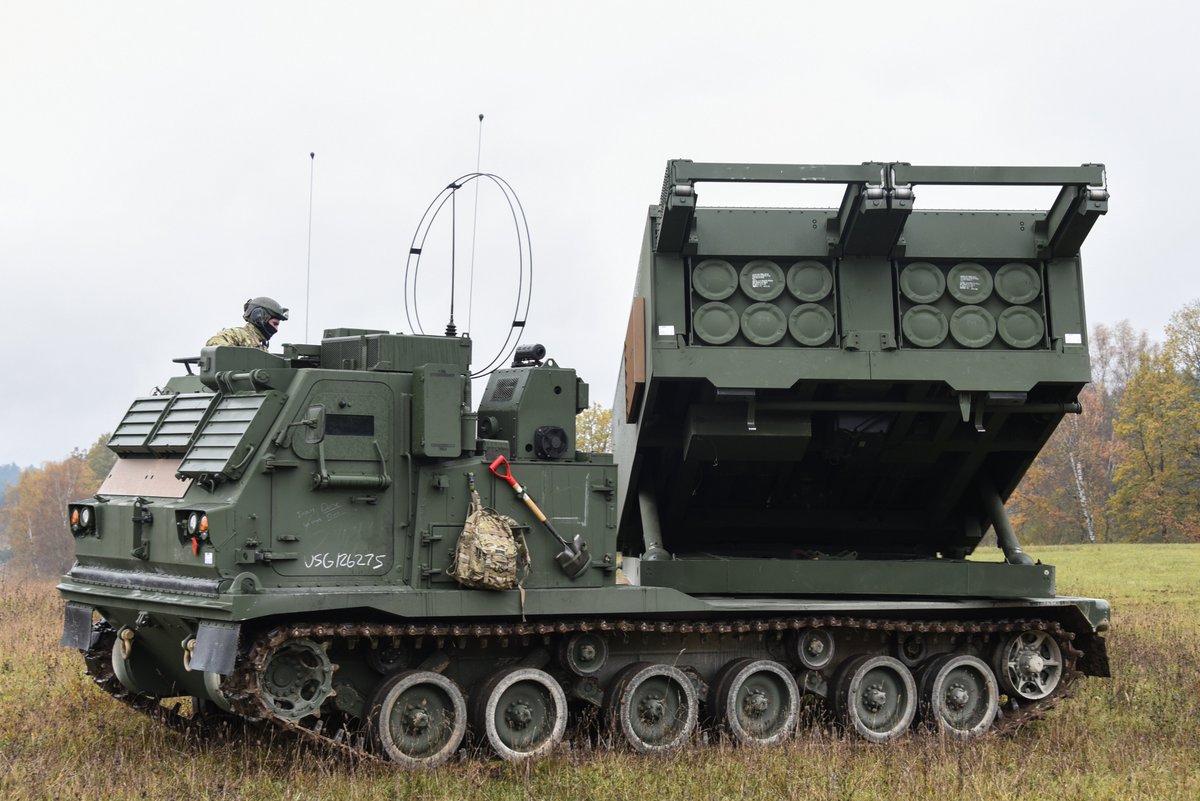
In my last thread I explained the differences between the:
 M270 MLRS and M142 HIMARS
M270 MLRS and M142 HIMARS
 BM-27 Uragan and BM-30 Smerch
BM-27 Uragan and BM-30 Smerch
and looked at what missiles are available for the M270 and M142. I suggest you read it before continuing with this thread.
2/n
Unroll available on Thread Reader
M270 MLRS and M142 HIMARS
Both have a crew of three, both fire the same missiles, both do not need a Fire Direction Center to compute their missions.
3/n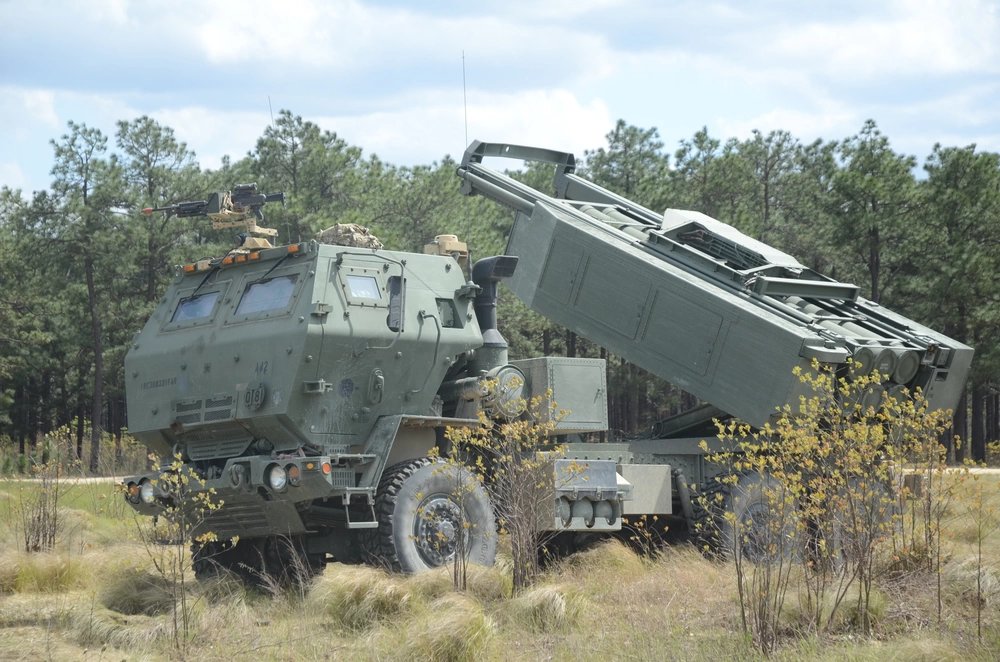
The M142 HIMARS exists in only one version. No updates so far - this version is called M142A0.
The M270 MLRS exists in three versions:
• M270A0
• M270A1
• M270A2
You can distinguish the A1/A2 from the earlier A0 by the GPS antenna on the launcher (red arrow).
4/n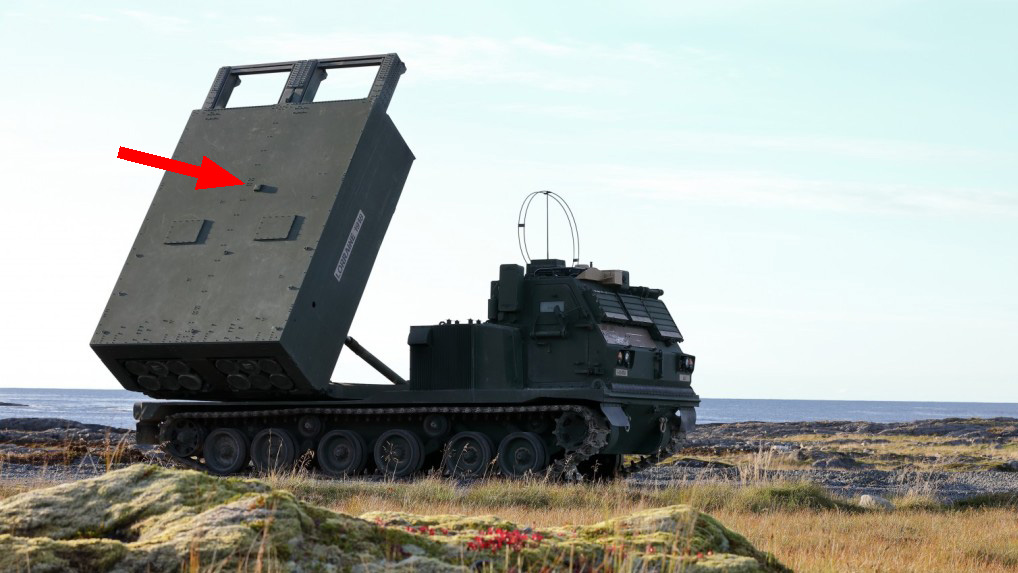
The M270A0 can only fire the M26 series, M28 series training rockets, and M39 rocket (photo: a M28 launch). As of 2022 no country fields the M270A0.
The M270A1 can fire all current missiles, but its processing power is too slow to fire the future PrSM missile.
5/n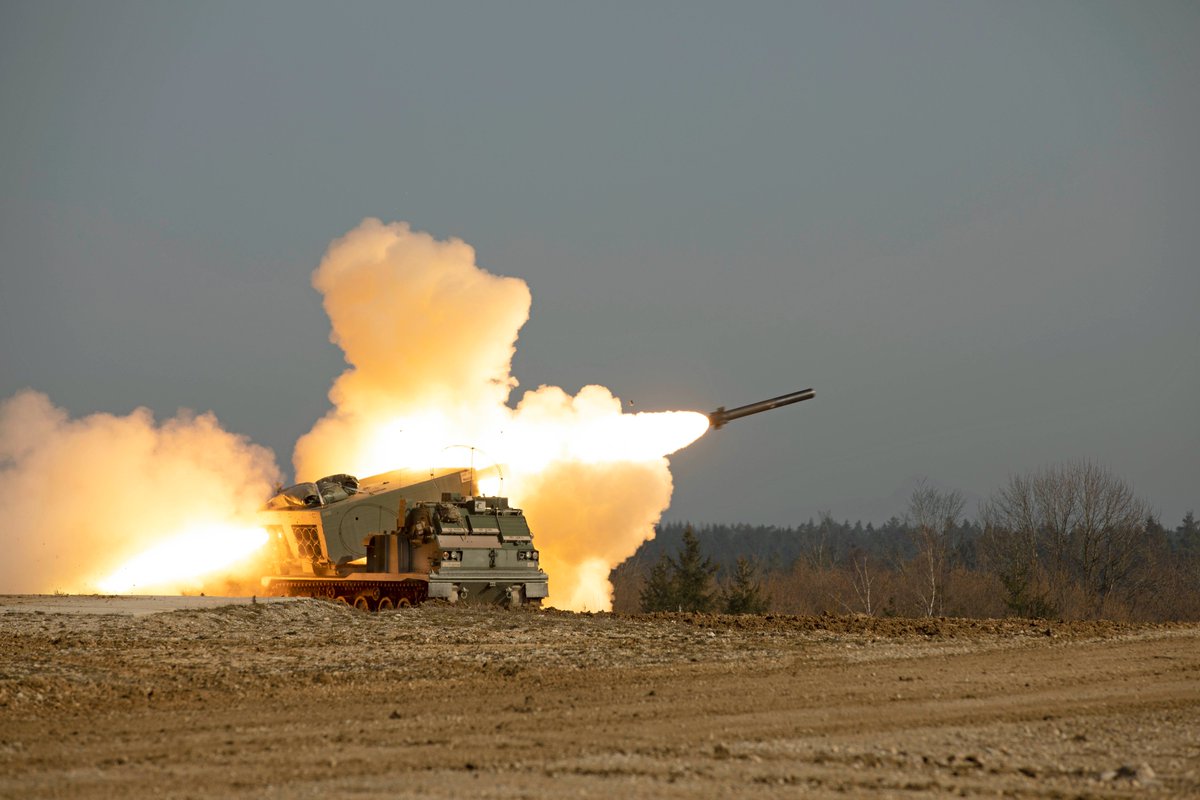
Therefore Lockheed Martin is currently overhauling and upgrading 160 stored M270A0 with new engines, transmissions, launcher-loader modules, and the new Common Fire Control System (CFCS) - this version will be known as M270A2.
These 160 new M270A2 will equip the currently
6/n
active ten US Army and US Army National Guard artillery battalions, which all use the M270A1.
When these 160 M270A2 have been delivered Lockheed will begin to overhaul and upgrade the existing fleet of 225 M270A1 launchers to the new M270A2 standard.
7/n
Once the overhauled M270A1 leave the Lockheed facilities as M270A2 the Army will raise new artillery battalions and increase the number of launchers per battalion.
All this means that Ukraine can only get either M142 or M270A1 launchers, because the M270A0 can't fire the
8/n
GPS guided GMLRS missiles in the US inventory, while the M270A2 is the pinnacle of US military tech and its CFCS is top secret.
This leaves the M270A1 as only possible M270 variant, and luckily Lockheed is right now delivering the first M270A2 to US Army artillery units,
9/n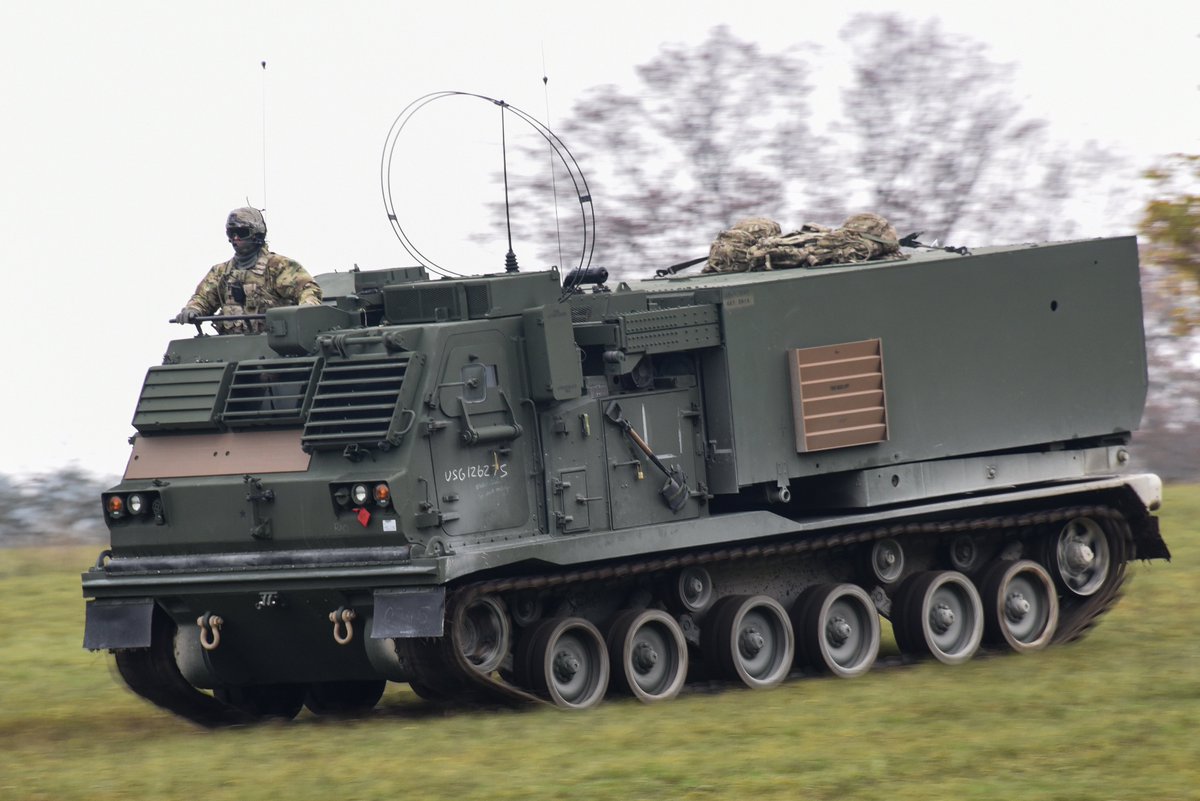
which are concurrently retiring their M270A1.
As for the M142: more than 540 have been produced so far and the US Army and Marine inventory is around 450 systems, with approximately 335 in active units.
In short: the US could donate a lot of either system to Ukraine,
10/n
as of both 100+ are available and as both systems can be replaced by the US defense industry.
The main difference between the two systems is that the M142 carries only one missile pod. As pods contain the same 6x missiles (either 6x M30A1, 6x M31, or 6x M31A1) this somewhat
11/n
limits a artillery commander's options... unless he has two M142 loaded with different missiles.
The M270A1 carries two pods and so can fire unitary warheads (M31/M31A1) and alternative warhead (M30A1) rockets in the same fire mission.
Photo: a M31 launch in Iraq
12/n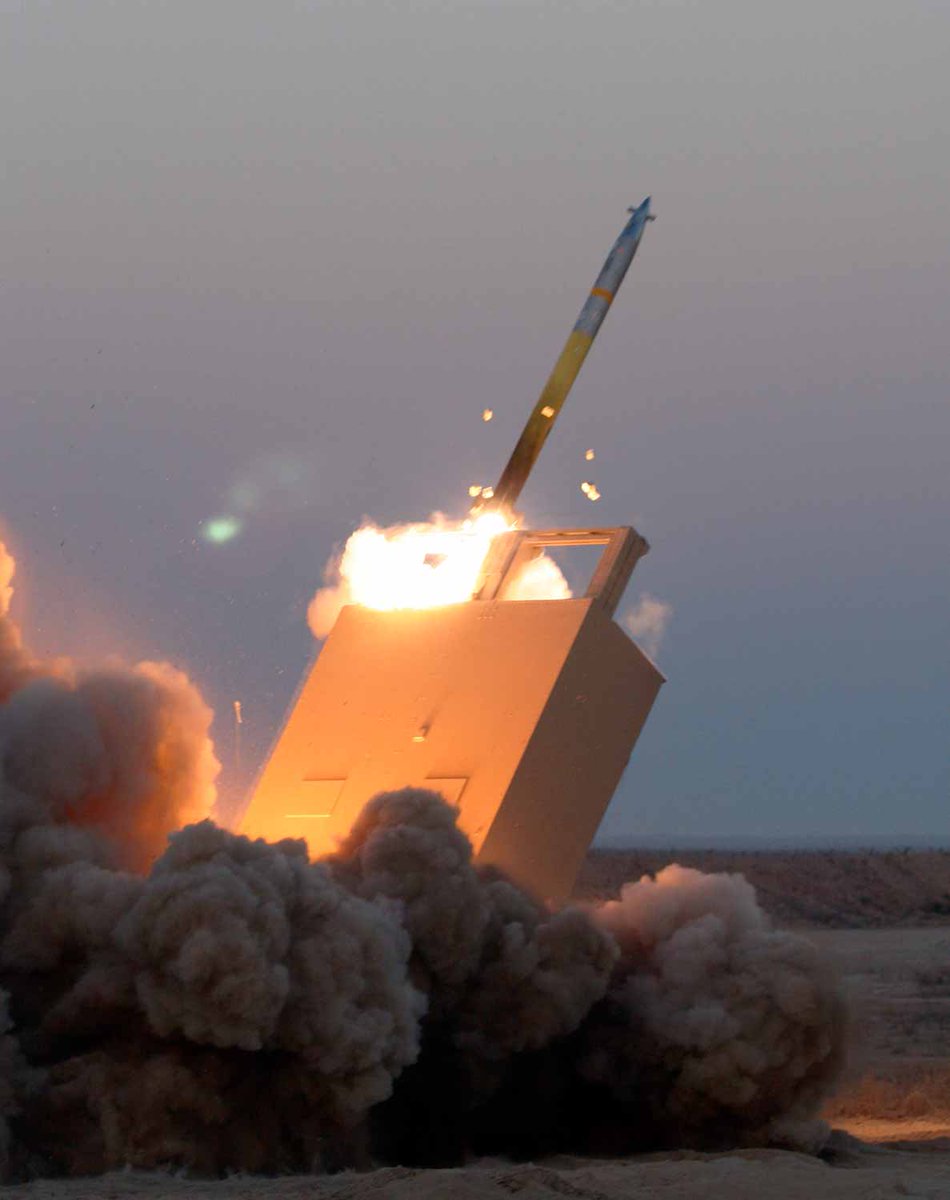
Both systems can fire a LOT more missions per hour than russian systems.
As mentioned in my earlier tweet it takes 20+ minutes to reload the Uragan (photo) and 40+ minutes to reload the Smerch.
M142 and M270A1 reload time: 5 minutes.
13/n
Then the russians have to measure and set up their firing positions, plot a fire mission with their outdated maps, sight their launchers optically (photo) - this and their slow reloading time mean that the russians can fire one volley per hour at best...
14/n
The M142 and M270A1 need 1 minute to stop, set up and fire their missiles:
drone spots a russian target - sends GPS coordinates to the M142 - gunner enters GPS coordinates into the UFCS - launches missiles - moves on.
A M142 or M270A1 can fire 5-6 volleys per hour (!).
15/n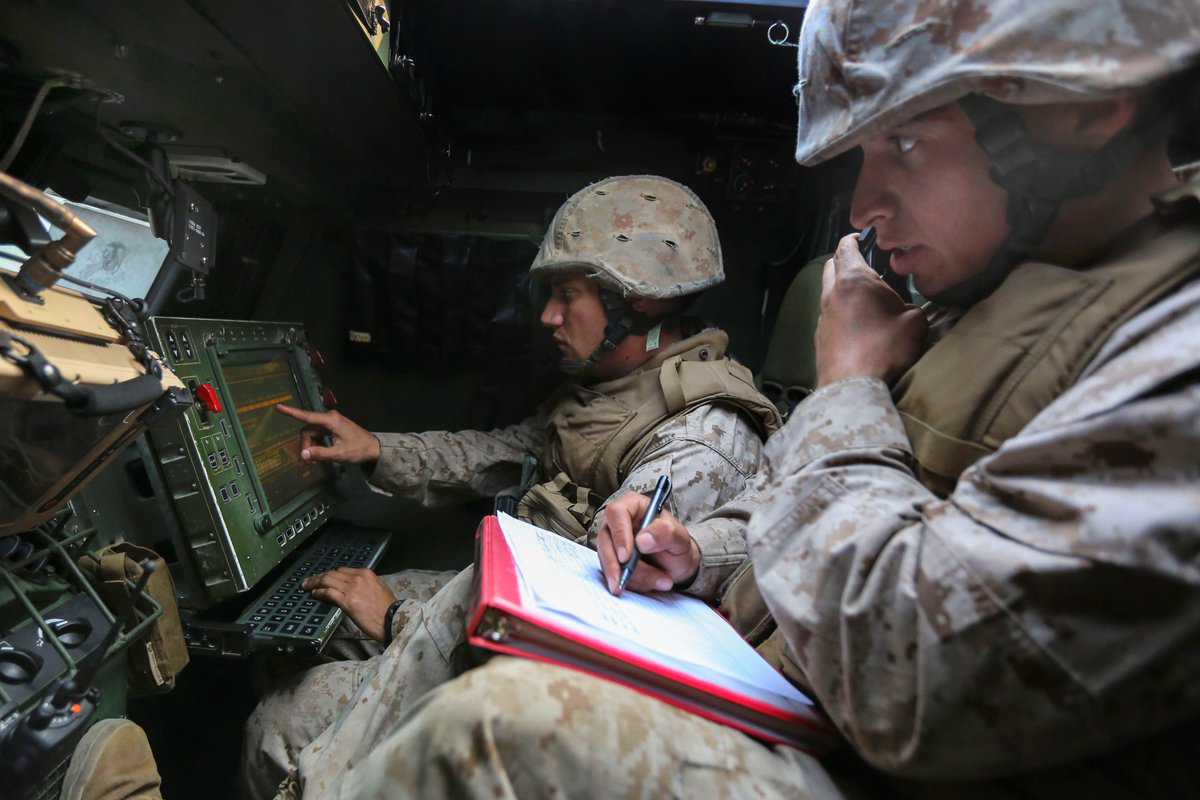
Not only are M142 and M270A1 faster to reload, quicker to fire, and massively more accurate than russian rocket launchers - their missiles also fly further than russian missiles.
Officially GMLRS missiles have a range of 70 km... I can tell you that this is not true.
16/n
Just how much further their real range is I cannot disclose, but the russians are about to make painful discoveries soon.
We now know which launchers and missiles Ukraine will receive... now let's look at how these missiles will deliver a lot of hurt to the russians.
17/n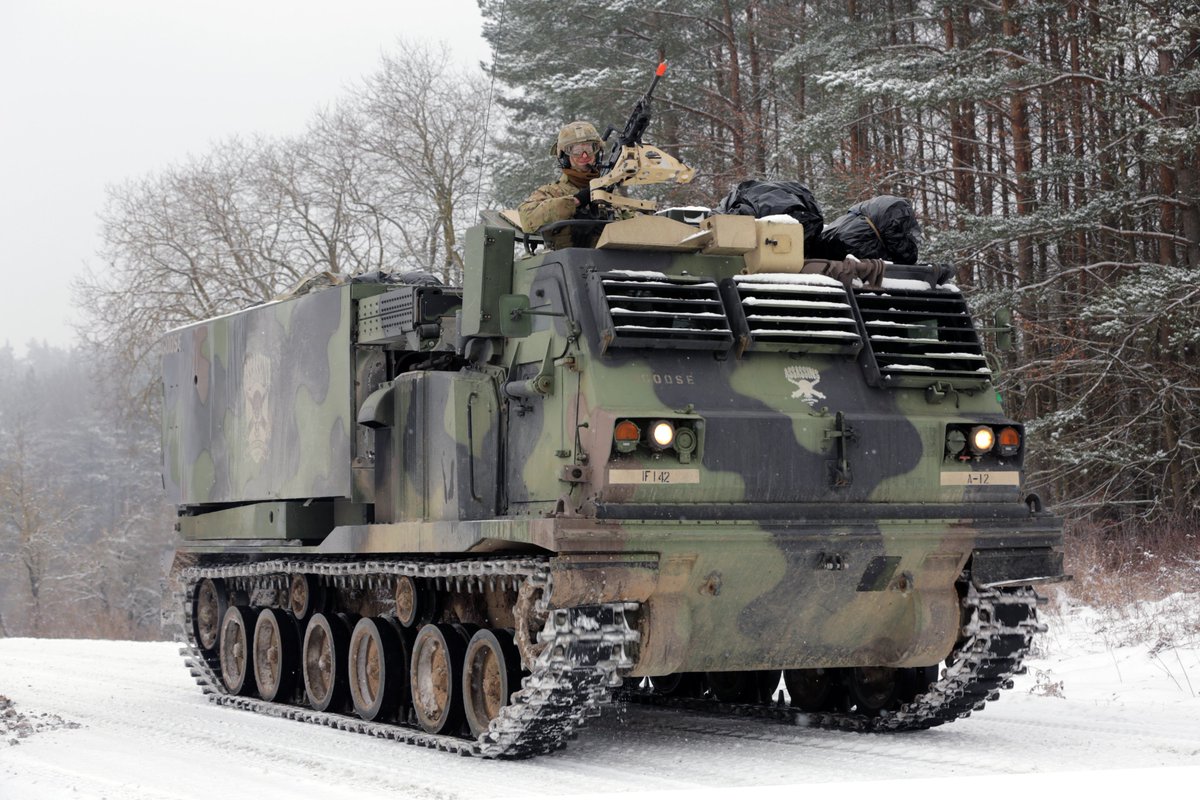
Let's look first at the Kherson front.
I used @Nrg8000's brilliant maps for these:
• in the 1st image I added two blue circles with the range of M777 howitzers with M795 projectiles
• in the 2nd image I added a yellow circle with the "official" range of a M31A1 rocket
18/n

Just one M142 or M270A1 can not only fire at almost every russian position in Kherson Oblast, it can also hit the choke points of russia's two supply lines:
• the Antonovskiy Bridge near Kherson and
• the Kakhovka Dam near Nova Kakhovka
19/n
Send up a drone:
• find russian supply point - hit it with a M30A1
• find a russian command post - hit it with a M31A1
• find a russian battery - give it a taste of both
• find russian infantry - one M30A1 will hit them with 160,000 scorching hot, 3 Mach fast shrapnels
20/n
Now let's look at Kharkiv.
In blue the range of a M777 with M795 projectile, and in green the range of a self-propelled CAESAR howitzer.
In yellow the "official" range of where a M270A1 or M142 can make the russian's life hell.
21/n

The entire russian supply line using the railway from Vovchansk to Kupiansk is in range. The russian supply point at Kupiansk, which supplies the russian salient at Izyum is in range.
And there is no need to worry about counter battery fire: M142 and M270A1 fire their
22/n
missiles so quickly that whatever russia fires in return will hit long after both vehicles are gone.
The M142 crew doesn't even have to get out of their vehicle to reload. The only risk to them are drones. So both vehicles need air defense close by.
23/n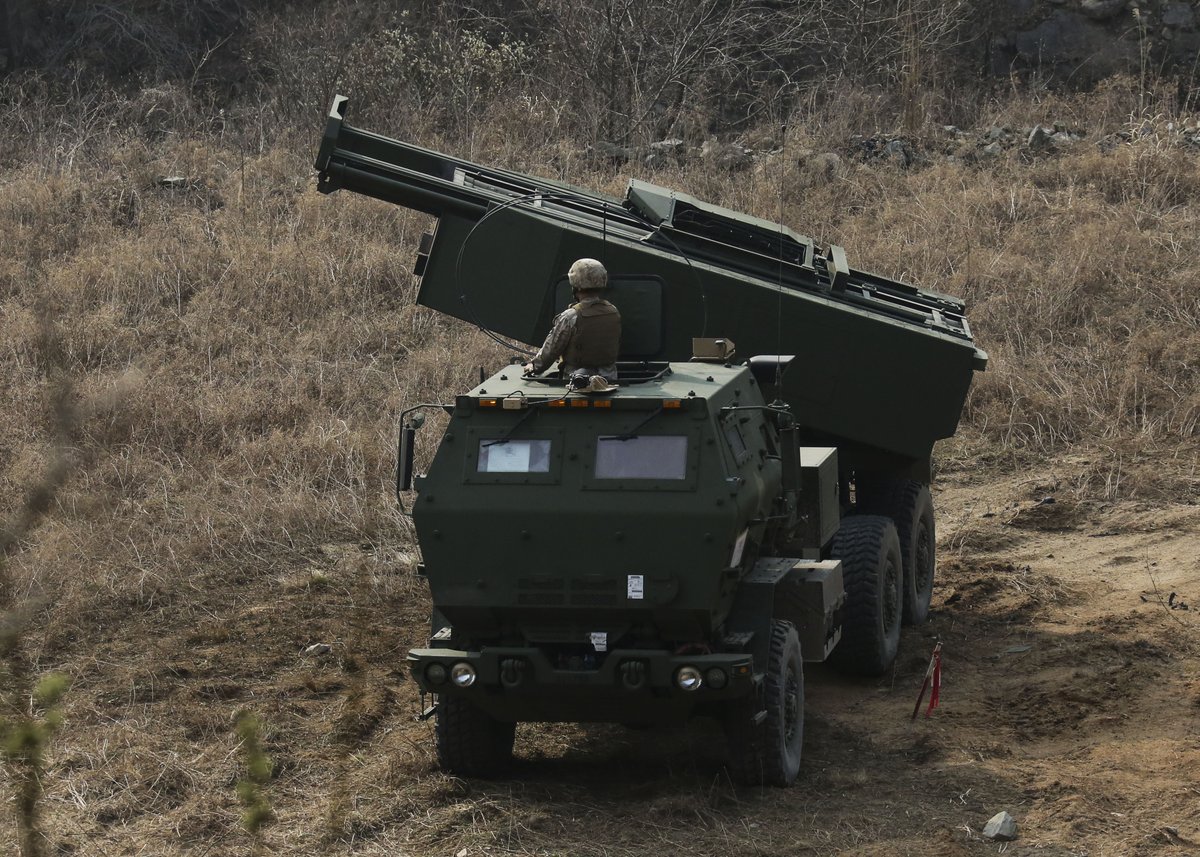
And now we look at the Donbas front. Two M777 in blue and one CAESAR in green... and compare this to what one M270A1 or M142 can cover.
A handful of M142 moving constantly around in the Donbas area, stopping only to fire or reload can hit attacking russian troops anywhere.
24/n

If a russian battery or air defense system is spotted deep behind russian lines - drive closer to the frontline, fire the missiles, move back out of russian artillery range.
Then reload and repeat.
25/n
M270A1 and/or M142 are definitely going to change the dynamics of this war.
Every russian attack will get smited, every russian supply point will get destroyed. And we already know that russia can't move further than 80-90 km supply points.
26/n
But Ukraine needs a lot of M270A1 or M142. As @nicholadrummond already said: 48x launchers is the minimum. Plus lots and lots of missiles, and drones to spot every russian position.
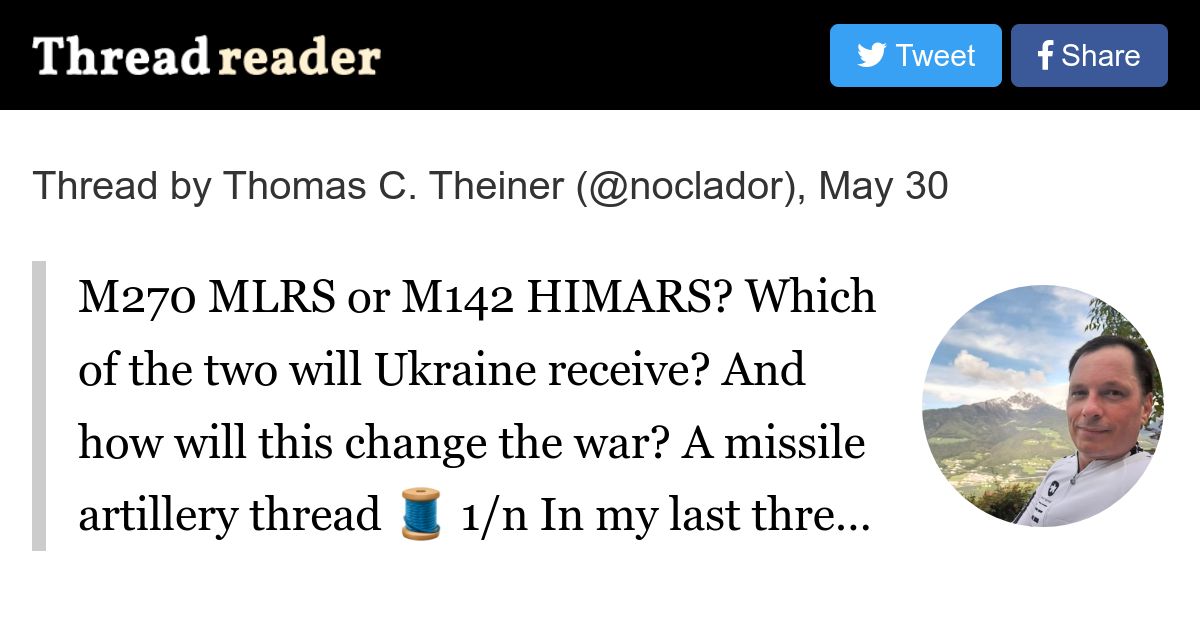
 threadreaderapp.com
threadreaderapp.com
Which of the two will Ukraine receive?
And how will this change the war?
A missile artillery thread
1/n

In my last thread I explained the differences between the:
and looked at what missiles are available for the M270 and M142. I suggest you read it before continuing with this thread.
2/n
Unroll available on Thread Reader
The US has two multiple launch rocket systems:
M270 MLRS and M142 HIMARS
Both have a crew of three, both fire the same missiles, both do not need a Fire Direction Center to compute their missions.
3/n

The M142 HIMARS exists in only one version. No updates so far - this version is called M142A0.
The M270 MLRS exists in three versions:
• M270A0
• M270A1
• M270A2
You can distinguish the A1/A2 from the earlier A0 by the GPS antenna on the launcher (red arrow).
4/n

The M270A0 can only fire the M26 series, M28 series training rockets, and M39 rocket (photo: a M28 launch). As of 2022 no country fields the M270A0.
The M270A1 can fire all current missiles, but its processing power is too slow to fire the future PrSM missile.
5/n

Therefore Lockheed Martin is currently overhauling and upgrading 160 stored M270A0 with new engines, transmissions, launcher-loader modules, and the new Common Fire Control System (CFCS) - this version will be known as M270A2.
These 160 new M270A2 will equip the currently
6/n
active ten US Army and US Army National Guard artillery battalions, which all use the M270A1.
When these 160 M270A2 have been delivered Lockheed will begin to overhaul and upgrade the existing fleet of 225 M270A1 launchers to the new M270A2 standard.
7/n

Once the overhauled M270A1 leave the Lockheed facilities as M270A2 the Army will raise new artillery battalions and increase the number of launchers per battalion.
All this means that Ukraine can only get either M142 or M270A1 launchers, because the M270A0 can't fire the
8/n
GPS guided GMLRS missiles in the US inventory, while the M270A2 is the pinnacle of US military tech and its CFCS is top secret.
This leaves the M270A1 as only possible M270 variant, and luckily Lockheed is right now delivering the first M270A2 to US Army artillery units,
9/n

which are concurrently retiring their M270A1.
As for the M142: more than 540 have been produced so far and the US Army and Marine inventory is around 450 systems, with approximately 335 in active units.
In short: the US could donate a lot of either system to Ukraine,
10/n

as of both 100+ are available and as both systems can be replaced by the US defense industry.
The main difference between the two systems is that the M142 carries only one missile pod. As pods contain the same 6x missiles (either 6x M30A1, 6x M31, or 6x M31A1) this somewhat
11/n
limits a artillery commander's options... unless he has two M142 loaded with different missiles.
The M270A1 carries two pods and so can fire unitary warheads (M31/M31A1) and alternative warhead (M30A1) rockets in the same fire mission.
Photo: a M31 launch in Iraq
12/n

Both systems can fire a LOT more missions per hour than russian systems.
As mentioned in my earlier tweet it takes 20+ minutes to reload the Uragan (photo) and 40+ minutes to reload the Smerch.
M142 and M270A1 reload time: 5 minutes.
13/n

Then the russians have to measure and set up their firing positions, plot a fire mission with their outdated maps, sight their launchers optically (photo) - this and their slow reloading time mean that the russians can fire one volley per hour at best...
14/n

The M142 and M270A1 need 1 minute to stop, set up and fire their missiles:
drone spots a russian target - sends GPS coordinates to the M142 - gunner enters GPS coordinates into the UFCS - launches missiles - moves on.
A M142 or M270A1 can fire 5-6 volleys per hour (!).
15/n

Not only are M142 and M270A1 faster to reload, quicker to fire, and massively more accurate than russian rocket launchers - their missiles also fly further than russian missiles.
Officially GMLRS missiles have a range of 70 km... I can tell you that this is not true.
16/n
Just how much further their real range is I cannot disclose, but the russians are about to make painful discoveries soon.
We now know which launchers and missiles Ukraine will receive... now let's look at how these missiles will deliver a lot of hurt to the russians.
17/n

Let's look first at the Kherson front.
I used @Nrg8000's brilliant maps for these:
• in the 1st image I added two blue circles with the range of M777 howitzers with M795 projectiles
• in the 2nd image I added a yellow circle with the "official" range of a M31A1 rocket
18/n


Just one M142 or M270A1 can not only fire at almost every russian position in Kherson Oblast, it can also hit the choke points of russia's two supply lines:
• the Antonovskiy Bridge near Kherson and
• the Kakhovka Dam near Nova Kakhovka
19/n
Send up a drone:
• find russian supply point - hit it with a M30A1
• find a russian command post - hit it with a M31A1
• find a russian battery - give it a taste of both
• find russian infantry - one M30A1 will hit them with 160,000 scorching hot, 3 Mach fast shrapnels
20/n
Now let's look at Kharkiv.
In blue the range of a M777 with M795 projectile, and in green the range of a self-propelled CAESAR howitzer.
In yellow the "official" range of where a M270A1 or M142 can make the russian's life hell.
21/n


The entire russian supply line using the railway from Vovchansk to Kupiansk is in range. The russian supply point at Kupiansk, which supplies the russian salient at Izyum is in range.
And there is no need to worry about counter battery fire: M142 and M270A1 fire their
22/n
missiles so quickly that whatever russia fires in return will hit long after both vehicles are gone.
The M142 crew doesn't even have to get out of their vehicle to reload. The only risk to them are drones. So both vehicles need air defense close by.
23/n

And now we look at the Donbas front. Two M777 in blue and one CAESAR in green... and compare this to what one M270A1 or M142 can cover.
A handful of M142 moving constantly around in the Donbas area, stopping only to fire or reload can hit attacking russian troops anywhere.
24/n


If a russian battery or air defense system is spotted deep behind russian lines - drive closer to the frontline, fire the missiles, move back out of russian artillery range.
Then reload and repeat.
25/n

M270A1 and/or M142 are definitely going to change the dynamics of this war.
Every russian attack will get smited, every russian supply point will get destroyed. And we already know that russia can't move further than 80-90 km supply points.
26/n

But Ukraine needs a lot of M270A1 or M142. As @nicholadrummond already said: 48x launchers is the minimum. Plus lots and lots of missiles, and drones to spot every russian position.

Thread by @noclador on Thread Reader App
@noclador: M270 MLRS or M142 HIMARS? Which of the two will Ukraine receive? And how will this change the war? A missile artillery thread 🧵 1/n In my last thread I explained the differences between the: 🇺🇸...…
For start Ukraine urges just MLRS within min 20-25km range in order to push back enemy artillery from outskirts of big cities like Kharkiv.M270 MLRS or M142 HIMARS?
Last edited:
Here is the opinion of an opposition blogger banned in Russia, Alexei Kungurov. His site in Russia is blocked, I read with the help of a free VPN.
Can Ukraine defeat Russia on the battlefield?
A month ago, such a question would have caused only a condescending smile. And even today, after two months of fighting, Kiev has only one battle won, and even then at sea (the destruction of the flagship of the Black Sea Fleet "Moscow"), which practically does not change the balance of forces. Nevertheless, today it is already possible to discuss the potential possibility of a military defeat of Russia.
A reservation should be made here. The defeat of Putler in the Third World War, and the war has already acquired a global character, of course, is inevitable. But political defeat can come even as a result of the most victorious war. For example, the Soviet Army in Afghanistan solved all the tasks assigned to it. But the political goals of the war were not achieved, the USSR completely failed the war – it spent resources, suffered very significant losses, received sanctions, but most importantly, suffered enormous moral damage as a result of this aggression. It is enough to recall the boycott of the Olympic Games-80 in Moscow by more than 60 countries.
And, in fact, for what was this 10-year massacre conducted? It would be fine if there was some openly hostile regime in power in Afghanistan, which managed to be replaced by a friendly one. Then it would be possible to justify all this by saying that Moscow has strengthened the security of its southern borders. But after all, both before the invasion and after, the pro-Soviet-oriented PDPA remained in power in the country. And the fact that there was a constant squabble inside it, sometimes even a massacre, between the "Khalq" and "Parcham" factions – so this is a completely ordinary matter for the native regimes.
But no, the Kremlin was offended that the Afghan comrades were pursuing too independent an internal policy and started a "small victorious special operation" that resulted in the collapse of the regime loyal to Moscow. However, this happened after the collapse of the USSR, which formally makes it possible to assert that the country did not lose the war, because it did not live up to this moment. But this is an excuse from the same category that the Russian Empire did not lose in the First World War, since the Brest Peace was already signed by the Bolsheviks. Everything is much sadder – the Romanov empire died as a result of this last war for itself. After all, dying as a result of a fight is much worse than just being beaten.
Another example of a victorious defeat is the Russian–Turkish War of 1877-1878. On the battlefield, the Russian army won a victory, although not very convincing, but it was not possible to consolidate its results politically: the San Stefano peace with Turkey was annulled during the Berlin Congress by European powers that did not even participate in the war.
Politically, the Kremlin has already lost the war with Ukraine with a bang. The concept of victory in the war is very specific and does not allow for misconceptions: the achievement of peace, better than the pre-war one, is considered a victory. The best for the winner, of course. But even idiots can guess that the international isolation that Rasha has fallen into cannot exactly be considered a better world than the pre-war one. And what is especially disastrous – even just a return to the pre-war "bad world" is impossible in the event of a military defeat of Ukraine. The possibility of revising the status of a rogue state for the Russian Federation will arise only as a result of the collapse of the Putler regime and political capitulation to the world community and Ukraine itself. We will have to return the conquered territories and pay reparations in excess of more than half a trillion dollars already paid by the Kremlin (these are frozen currency funds of the Central Bank and seized assets of the oligarchs).
It is safe to say that the war will lead, at least, to the collapse of the Putler regime, at most – to the death of Russia as a historical subject (this is still unlikely, but not excluded). However, until recently, the probability that Ukraine would be the one to take the Russian bear looked frankly fantastic. Not anymore.
And even the inability of Ukrainians to win on the battlefield (so far) does not prevent this. It is enough to recall the collapse of Napoleon's victorious campaign in Russia in 1812. Formally, he beat the Russian troops in all battles, including the general Borodino, took Moscow and robbed it. But strategically, the company was defeated. If you don't go into details, then the alignment was like this. War is a resource competition. Napoleon spent his superior military resources on victories during the six-month campaign, but was unable to DESTROY Russia's military resources, which did not allow him to dictate peace terms to St. Petersburg and politically record the results of his victories in field battles. And without political consolidation of military successes, it is impossible to achieve a better world than the pre-war one.
Thus, it was not yet a war, but the campaign was recognized by Bonaparte as a failure, and he decided to leave Russia, which he had "conquered". Contrary to the widespread stereotype about the defeat of Napoleon's troops, he was able to do this relatively successfully. Yes, the interventionists' losses were large, mainly from frost, but the Russian army, which pursued them, not daring to enter the battle, also had losses that were just as great.
As a commander, Russian Field Marshal Kutuzov is an outright loser. In his career there were two general battles – Austerlitz and Borodino, and he shamefully merged both. It was shameful, because in both cases he had an advantage over the enemy. However, as a strategist, Mikhail Illarionovich was a head superior to Napoleon, the genius of field battle. Operational art teaches you to win battles, but strategy is the science of winning wars, where the army is only one of the tools.
That is, reasoning by analogy, Ukraine will be able to achieve victory in the course of hostilities, only by avoiding the complete destruction of the Armed Forces of Ukraine, depriving the occupiers of the resources necessary to continue the offensive war during the confrontation, while retaining the ability to wage a defensive war. The bottom line is that victories and defeats are equally suitable for grinding the invaders' resources.
It is not necessary that the occupiers' losses should exceed the Ukrainian ones. What matters is the ability to replenish resources. In this sense, no matter how crazy this thought may seem to cotton wool, the resource capabilities of Ukraine are increasing every day, and the resource potential of the Russian Federation is melting. We do not forget that the war is global in nature, and the Western countries make up for Ukraine's technical shortcomings. The greater the losses the APU will bear, the more actively the partners will feed Kiev with material assets.
The Ukrainian side also has an advantage in human resources. Don't be surprised. The fact is that it can mobilize, both to make up for losses in manpower, and to increase the number of troops. Society, of course, is not enthusiastic about mobilization, but a consensus has been reached on the need for it. The mobilization potential of the country is up to one and a half million people. Nominally, it is even more – 2.5 million, but it is worth understanding that overmobilization leads to a weakening of the resource base for waging war, so it is impossible to overdo it in this matter.
The Russian Federation is a much larger country than Ukraine, and formally Putler can put up to six million reservists under arms. But in fact, he does not have such an opportunity yet. To do this, it is necessary to close the border, declare mobilization, train and equip soldiers, form new formations – that's only then the invaders will have the opportunity to crush the enemy with "meat". But the question arises: will the fourth Reich pull the total war regime economically, and, most importantly, psychologically? Yes, the population unequivocally supports military expansion, but this is exactly the case when passive support is not enough, active participation is also needed. And the queues of volunteers who are eager to "beat bender" do not line up at military enlistment offices. I believe that even the draft plan will not be fulfilled, or it will be possible with titanic efforts.
The announcement of Today's general mobilization will mean his political failure – the collapse of the concept of "special operation" as a means to achieve the goal (what this goal is, by the way, there was no clarity, and there is no). It's one thing when the war is only on TV, and victoriously and "with little blood on someone else's territory," and quite another if it concerns you personally. I have no doubt that the Fuhrer, in order to avoid the disgrace of military defeat and loss of power, will declare mobilization. But whether the ruling regime will pull it is a big question.
Mobilization will hit the economy hard, from which colossal resources will be withdrawn while spending on a full-scale war will increase. The escalation of the conflict will cause the guaranteed introduction of new economic sanctions, which will further complicate the situation. Finally, do not discount such an important point as time. The population, no matter how bombed by propaganda, is not able to withstand prolonged military tension, the consequence of which is a significant decrease in living standards.
Ukrainian society is put in a situation where it is forced to endure the costs of war, because the country is a victim of aggression. This gives an incentive to overstrain: they say, we will strain ourselves, we will expel the aggressor – then life will get better. Only catastrophic military failures, which Ukraine managed to avoid, can undermine the will to resist. But it is much more difficult to justify the need to pay with blood and living standards in the name of waging a protracted aggressive war. Especially if the society is not something that does not share, but does not even understand the goals of the war. Especially if the war is bloody and unsuccessful. In this case, the slogan "Down with the war!" is rapidly gaining popularity, which creates the threat of an internal political catastrophe of the February 1917 model.
Thus, for the time being, Putler has only very limited human resources of the cadre army and a certain number of volunteers, by the way, of very dubious quality. After all, people go to war not for ideological reasons, but almost exclusively because of poverty. To put it bluntly, volunteers are mostly marginal rabble from subsidized regions.
Can Ukraine defeat Russia on the battlefield?
A month ago, such a question would have caused only a condescending smile. And even today, after two months of fighting, Kiev has only one battle won, and even then at sea (the destruction of the flagship of the Black Sea Fleet "Moscow"), which practically does not change the balance of forces. Nevertheless, today it is already possible to discuss the potential possibility of a military defeat of Russia.
A reservation should be made here. The defeat of Putler in the Third World War, and the war has already acquired a global character, of course, is inevitable. But political defeat can come even as a result of the most victorious war. For example, the Soviet Army in Afghanistan solved all the tasks assigned to it. But the political goals of the war were not achieved, the USSR completely failed the war – it spent resources, suffered very significant losses, received sanctions, but most importantly, suffered enormous moral damage as a result of this aggression. It is enough to recall the boycott of the Olympic Games-80 in Moscow by more than 60 countries.
And, in fact, for what was this 10-year massacre conducted? It would be fine if there was some openly hostile regime in power in Afghanistan, which managed to be replaced by a friendly one. Then it would be possible to justify all this by saying that Moscow has strengthened the security of its southern borders. But after all, both before the invasion and after, the pro-Soviet-oriented PDPA remained in power in the country. And the fact that there was a constant squabble inside it, sometimes even a massacre, between the "Khalq" and "Parcham" factions – so this is a completely ordinary matter for the native regimes.
But no, the Kremlin was offended that the Afghan comrades were pursuing too independent an internal policy and started a "small victorious special operation" that resulted in the collapse of the regime loyal to Moscow. However, this happened after the collapse of the USSR, which formally makes it possible to assert that the country did not lose the war, because it did not live up to this moment. But this is an excuse from the same category that the Russian Empire did not lose in the First World War, since the Brest Peace was already signed by the Bolsheviks. Everything is much sadder – the Romanov empire died as a result of this last war for itself. After all, dying as a result of a fight is much worse than just being beaten.
Another example of a victorious defeat is the Russian–Turkish War of 1877-1878. On the battlefield, the Russian army won a victory, although not very convincing, but it was not possible to consolidate its results politically: the San Stefano peace with Turkey was annulled during the Berlin Congress by European powers that did not even participate in the war.
Politically, the Kremlin has already lost the war with Ukraine with a bang. The concept of victory in the war is very specific and does not allow for misconceptions: the achievement of peace, better than the pre-war one, is considered a victory. The best for the winner, of course. But even idiots can guess that the international isolation that Rasha has fallen into cannot exactly be considered a better world than the pre-war one. And what is especially disastrous – even just a return to the pre-war "bad world" is impossible in the event of a military defeat of Ukraine. The possibility of revising the status of a rogue state for the Russian Federation will arise only as a result of the collapse of the Putler regime and political capitulation to the world community and Ukraine itself. We will have to return the conquered territories and pay reparations in excess of more than half a trillion dollars already paid by the Kremlin (these are frozen currency funds of the Central Bank and seized assets of the oligarchs).
It is safe to say that the war will lead, at least, to the collapse of the Putler regime, at most – to the death of Russia as a historical subject (this is still unlikely, but not excluded). However, until recently, the probability that Ukraine would be the one to take the Russian bear looked frankly fantastic. Not anymore.
And even the inability of Ukrainians to win on the battlefield (so far) does not prevent this. It is enough to recall the collapse of Napoleon's victorious campaign in Russia in 1812. Formally, he beat the Russian troops in all battles, including the general Borodino, took Moscow and robbed it. But strategically, the company was defeated. If you don't go into details, then the alignment was like this. War is a resource competition. Napoleon spent his superior military resources on victories during the six-month campaign, but was unable to DESTROY Russia's military resources, which did not allow him to dictate peace terms to St. Petersburg and politically record the results of his victories in field battles. And without political consolidation of military successes, it is impossible to achieve a better world than the pre-war one.
Thus, it was not yet a war, but the campaign was recognized by Bonaparte as a failure, and he decided to leave Russia, which he had "conquered". Contrary to the widespread stereotype about the defeat of Napoleon's troops, he was able to do this relatively successfully. Yes, the interventionists' losses were large, mainly from frost, but the Russian army, which pursued them, not daring to enter the battle, also had losses that were just as great.
As a commander, Russian Field Marshal Kutuzov is an outright loser. In his career there were two general battles – Austerlitz and Borodino, and he shamefully merged both. It was shameful, because in both cases he had an advantage over the enemy. However, as a strategist, Mikhail Illarionovich was a head superior to Napoleon, the genius of field battle. Operational art teaches you to win battles, but strategy is the science of winning wars, where the army is only one of the tools.
That is, reasoning by analogy, Ukraine will be able to achieve victory in the course of hostilities, only by avoiding the complete destruction of the Armed Forces of Ukraine, depriving the occupiers of the resources necessary to continue the offensive war during the confrontation, while retaining the ability to wage a defensive war. The bottom line is that victories and defeats are equally suitable for grinding the invaders' resources.
It is not necessary that the occupiers' losses should exceed the Ukrainian ones. What matters is the ability to replenish resources. In this sense, no matter how crazy this thought may seem to cotton wool, the resource capabilities of Ukraine are increasing every day, and the resource potential of the Russian Federation is melting. We do not forget that the war is global in nature, and the Western countries make up for Ukraine's technical shortcomings. The greater the losses the APU will bear, the more actively the partners will feed Kiev with material assets.
The Ukrainian side also has an advantage in human resources. Don't be surprised. The fact is that it can mobilize, both to make up for losses in manpower, and to increase the number of troops. Society, of course, is not enthusiastic about mobilization, but a consensus has been reached on the need for it. The mobilization potential of the country is up to one and a half million people. Nominally, it is even more – 2.5 million, but it is worth understanding that overmobilization leads to a weakening of the resource base for waging war, so it is impossible to overdo it in this matter.
The Russian Federation is a much larger country than Ukraine, and formally Putler can put up to six million reservists under arms. But in fact, he does not have such an opportunity yet. To do this, it is necessary to close the border, declare mobilization, train and equip soldiers, form new formations – that's only then the invaders will have the opportunity to crush the enemy with "meat". But the question arises: will the fourth Reich pull the total war regime economically, and, most importantly, psychologically? Yes, the population unequivocally supports military expansion, but this is exactly the case when passive support is not enough, active participation is also needed. And the queues of volunteers who are eager to "beat bender" do not line up at military enlistment offices. I believe that even the draft plan will not be fulfilled, or it will be possible with titanic efforts.
The announcement of Today's general mobilization will mean his political failure – the collapse of the concept of "special operation" as a means to achieve the goal (what this goal is, by the way, there was no clarity, and there is no). It's one thing when the war is only on TV, and victoriously and "with little blood on someone else's territory," and quite another if it concerns you personally. I have no doubt that the Fuhrer, in order to avoid the disgrace of military defeat and loss of power, will declare mobilization. But whether the ruling regime will pull it is a big question.
Mobilization will hit the economy hard, from which colossal resources will be withdrawn while spending on a full-scale war will increase. The escalation of the conflict will cause the guaranteed introduction of new economic sanctions, which will further complicate the situation. Finally, do not discount such an important point as time. The population, no matter how bombed by propaganda, is not able to withstand prolonged military tension, the consequence of which is a significant decrease in living standards.
Ukrainian society is put in a situation where it is forced to endure the costs of war, because the country is a victim of aggression. This gives an incentive to overstrain: they say, we will strain ourselves, we will expel the aggressor – then life will get better. Only catastrophic military failures, which Ukraine managed to avoid, can undermine the will to resist. But it is much more difficult to justify the need to pay with blood and living standards in the name of waging a protracted aggressive war. Especially if the society is not something that does not share, but does not even understand the goals of the war. Especially if the war is bloody and unsuccessful. In this case, the slogan "Down with the war!" is rapidly gaining popularity, which creates the threat of an internal political catastrophe of the February 1917 model.
Thus, for the time being, Putler has only very limited human resources of the cadre army and a certain number of volunteers, by the way, of very dubious quality. After all, people go to war not for ideological reasons, but almost exclusively because of poverty. To put it bluntly, volunteers are mostly marginal rabble from subsidized regions.
to be honest i dont really give a shit about both sides trying to prove they are rambos about the 1000s of equipment's they lost but losing territory does not = your winning or fending off the invaders by not getting more territory back, worst yet you keep getting yourself set up for ambush attacks to get constantly attacked from different sides. If Ukrainians get trained to use modern equipment than the Russians will start to go use theirs like the Tornado MRLS instead of the soviet gear to reduce the cost of the operation but where it stands right now losing territory does not = your winning.
russians fired on the evacuation vehicle, which was going to pick people up.
Most of people inside vehicle are dead including French journalist who was making material about the evacuation
was killed.
Most of people inside vehicle are dead including French journalist who was making material about the evacuation
was killed.
Last edited:
In russia, kids wearing military uniforms in this FSB office (Russian Orthodox Church) are singing "Holy War."
russian invaders are doing what they do best: Looting...........
Ukraine will need those Himars capable of firing the M30/31 to outrange the Russian Smerch. The advantage of the Himars and the M270 are already explained earlier, it allows rapid shoot and scoot especially in the counter battery role.For start Ukraine urges just MLRS within min 20-25km range in order to push back enemy artillery from outskirts of big cities like Kharkiv.
https://www.russiadefence.net/t4810p250-russian-mrls-grad-uragan-smerch-tornado-g-s i hope Ukrainians using those systems would get the Russians serious enough to use Agriculture, the tornado variants and TOS-2 systems since I want to see those in action. Like if the 200km version missiles of tornado can hit ER-GMLRS used by Ukrainians.Ukraine will need those Himars capable of firing the M30/31 to outrange the Russian Smerch. The advantage of the Himars and the M270 are already explained earlier, it allows rapid shoot and scoot especially in the counter battery role.
I guess this war was somewhat convenient for them to get rid of some old MRLS systems since they planned to replace all of their old versions by 2027.
Try again next time maybe. Russia is known to deploy its most advanced hardware into Ukraine, and that include advanced MLRSI guess this war was somewhat convenient for them to get rid of some old MRLS systems since they planned to replace all of their old versions by 2027.
You could boast all intended use of any weapons (as u usually did), but As I and @Nilgiri pointed out earlier, Russia will struggle to deliver modern weapons system simply because this, or therefore lack of .

There were at least 35 U.S.-made chips found in the Kh-101 cruise missile, including those manufactured by Texas Instruments, Atmel Corp. Rochester Electronics, Cypress Semiconductor, Maxim Integrated, XILINX, Infineon Technologies, Intel, Onsemi, and Micron Technology.
When they opened up the turreted electro-optical system of the Ka-52 Alligator, Ukraine specialists found 22 U.S.-made chips and one Korean-made chip. The U.S. manufacturers included Texas Instruments, IDT, Altera USA, Burr-Brown, Analog Devices Inc., Micron Technology, Linear Technology and TE Connectivity.

Captured Russian Weapons Are Packed With U.S. Microchips
Ukraine intelligence showed us lists of mostly U.S.-made microchips it says were found on captured or destroyed Russian military equipment.
Most of these are out of reach for Russia for now. Without these, modern electronics can't work. That includes any modern Russian weapons.
As @noclador pointed out earlier, this is how HIMARS crew operate their fires.

and this is how its adversaries direct their fires.

microchips enabled the former to operate that way.










